Getting the Math Right
Understanding what calculations need to be made and where within the system is key to ensuring the mechanical room has been sized properly.










INSIDE



n Breaking the stigma of mental health


n Smart bathrooms on the rise
n Greener Homes Grant rebate headaches
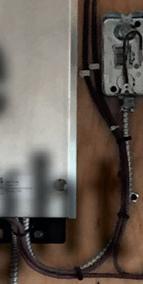

n When to simply close down the business

MAY/JUNE2023WWW.PLUMBINGANDHVAC.CA Publication Mail Agreement #43029513. Return postage guaranteed Marked Business Media Inc. 286 King Street W, Unit 203, Oshawa , Ontario, Canada L1J 2J9
With the Latest Innovations and Long-Lasting Reliability, it’s the Trusted INDIRECT WATER HEATER.
























www.plumbingandhvac.ca May/June 2023 – Plumbing & HVAC 3 n Contents Getting behind the math of hydronics34 Double check your calculations are correct before moving forward Subcooling & superheat42 Gathering these measurements are important to understand air conditioning systems Features Departments Hot Seat.........................................5 Keeping up to date Industry News ..............................6 Resources available to support mental health in construction industry Plumbing & HVAC, In the Field...47 Return of MCEE People & Places...........................51 Wolseley donates to clean water initiative Shop Management.....................52 Closing down the business Coming Events............................54 HRAI holding AGM in Montreal Products & Technologies Bath Products .............................19 Bath Feature ...............................20 Kitchen Products ........................25 HVAC ...........................................27 Tools & Instruments ...................33 Hydronics ....................................34 Controls ......................................41 Refrigeration ..............................42 Kitchen & Bath Rebate headaches More industry feedback was needed for the Greener Homes Grant Smart technology20 The bathroom has become the home’s hub for interconnected technology Cover: Instead of using generic math equations in classrooms, teachers could use hydronicbased calculations to show real world applications of the mechanical trades. Please see our article on page 34. Photo provided by Cordes Enterprises.














CENTURION® Superior Reliability & Advanced Technology Compact, 1600-2000 MBH water heater - Up to 65% less footprint vs. the competition Advanced Edge® Controller with O2 Trim technology - Self-adjusts and maintains optimal air-fuel ratios for peak efficiency, low emissions and maximum reliability Durable, corrosion-resistant AquaPLEX® duplex stainless steel - Fire tube heat exchanger backed by a 15-year warranty Su Ad C wA OD A(817) 335-9531 | pvi.com/centurion
All on board!
The industry is looking for training; they are looking for it to be in various formats, meaningin-personoronline.Youcouldmake the argument that both types have its benefit. There are the obvious answers, like virtual training has zero geographical restraints and in-persontrainingallowsforthetraineetoget the product in their hands. At the end of the day,I’dsaythatfinding amix-and-match style between the two types of training would be the best course of action.
Recently, the Heating, Refrigeration, and Air Conditioning Institute of Canada (HRAI) hosted its inaugural Heat Pump Symposium at the International Centre in Mississauga, Ont. The in-person event focused primarily on government-related issues, with a few technical sessions sprinkled in amongst the various keynote presentations and panel discussions.
The most encouraging and fascinating element to take away from the symposium was just how much the industry wants training and more specifically, heat pump training. At the beginning of the event, I had the privilege of speaking with one of our readers at the Plumbing & HVAC magazine booth. During our conversation, we discussed how important it is to use the proper language and to differentiate the type of heat pumps. For instance, instead of simply lumping all
heat pumps together into one category, it might be best practice for the industry, and for us, the industry press, to specify which type of heat pump has been used. Did the installation use a geothermal heat pump? Does the incentive only apply to air-to-air heat pumps? I could see how language will play an important role in the adoption of heat pump technology. No one likes looking dumb and new technology can be scary to adopt into one's own repertoire. Simple and precise language will be of the utmost importance moving forward; especially when the industry starts discussing things such as the lifespan of a system, installation costs, and efficiencies. Each type of heat pump will have its stats card, so to speak.
Heat pumps have been around in the industry for long enough. I have seen a push from all sides of the industry, including building experts, on heat pump technology. We might still be in the era of early adopters, but I highly suspect that won’t be for much longer. The decarbonization of our buildings is starting to happen quickly and it’s time to shine a light on lower-carbon technology. Or else, some might be left to the testaments of history, like the dinosaurs or dodo birds.
May/June 2023
Volume 33, Number 3 ISSN 1919-0395
Publisher
Mark Vreugdenhil
(289) 638-2133 ext.1
Cell: (416) 996-1031 mark@plumbingandhvac.ca
Editor
Leah Den Hartogh

(289) 638-2133 ext. 2
Cell: (289) 830-1217 leah@plumbingandhvac.ca
Assistant Editor Francesco Lo Presti (289) 638-2133 ext. 3 francesco@plumbingandhvac.ca

Contributing Writers
Glenn Mellors, Greg Scrivener, Michael Ridler, Ron Coleman
Design and Production
Tim Norton/Janet Popadiuk production@plumbingandhvac.ca
All articles and photos by Plumbing & HVAC staff unless noted.
PLUMBING & HVAC Magazine is published seven times annually by Marked Business Media Inc. and is written for individuals who purchase/ specify/approve the selection of plumbing, piping, hot water heating, fire protection, warm air heating, air conditioning, ventilation, refrigeration, controls and related systems and products throughout Canada.
Marked Business Media Inc.

286 King Street W, Unit 203, Oshawa, ON L1J 2J9 Tel: (289) 638-2133
Postmaster: Send all address changes and circulation inquiries to: Plumbing & HVAC Magazine, 286 King Street W, Unit 203, Oshawa, Ontario, Canada L1J 2J9. Canadian Publications Mail Sales Product Agreement No. 43029513. Postage paid at Toronto, ON.

Annual Subscription Canada: $40.00 plus applicable taxes, single copy $5.00 plus applicable taxes. Annual Subscription United States: $60.00
U.S. Annual Subscription foreign: $90.00 U.S.
Copyright 2023. The contents of this magazine may not be reproduced in any manner without the prior written permission of the Publisher.
A member of:

• Canadian Institute of Plumbing & Heating
• Mechanical Contractors Association of Canada
• Ontario Plumbing Inspectors Association
• American Society of Heating Refrigerating & Air Conditioning Engineers
• Heating Refrigeration and Air Conditioning Institute of Canada

• Refrigeration Service Engineers Society of Canada

n Hot Seat
Facebook: @PlumbingandHVAC Twitter: @Plumbing_HVAC_ Instagram: plumbing_hvac_ YouTube: @plumbing-hvacmagazine LinkedIn: Plumbing + HVAC Magazine
What to know about Amendment 15
By MichaelRidler
Amendment 15 introduced minimum energy performance standards, testing standards, verification and reporting requirements for several product categories in the mechanical trades.
In the residential sector, it affects electric furnaces, gas boilers, fireplaces and furnaces, heat recovery ventilators (HRVs), oil boilers, and tankless water heaters. For the commercial sector, it’ll affect gas boilers, oil boilers, electric water heaters, and gas and oil water heaters.
The amendment was published in the Canada Gazette, Part 2 in June 2019. One of the bigger issues with water heaters is the use of VS, which uses the measured volume of the water heaters to determine the efficiency of the units, rather than VR. The Department of Energy (DOE) uses VR to calculate efficiency whereas Canada uses VS, which causes grief for the manufacturers. Additionally, with the water heater, there is an issue regarding standby losses with electric water heaters.

Replacement commercial water heaters may now be replaced with a like-unit, but it must have a label indicating that it is for replacement only
Condensing boilers have been regulated into residential applications for years, but commercial boilers being required to be condensing technology goes into effect on July 1, 2025. The big issue with this regulation is that it includes replacement boilers. This seriously impacts the building owner with additional costs for venting. If the building has a standard installation of commonly vented boilers and they must replace one boiler, they may require changing them all to support the venting of the new boiler.
There are several identified problems with a replacement boiler. NRCan has been working with the Canadian Institute of Plumbing and Heating’s members to create a “Best Practices Guide” to guide contractors and building owners. This document that was set to be released in June 2021, but has yet to be released.
6 Plumbing & HVAC – May/June 2023 www.plumbingandhvac.ca n Industry News
This table gives a clear indication on the effected energy efficiency standards and which product it applies to. Graphic and data provided by Natural Resources Canada
Commercial gas boilers
Commercial gas boilers used for space heating in buildings and can either use hot water or steam will be affected; this applies to natural gas or propane as the fuel source which have input ratings greater than or equal to 87.92 kW (300,000 btu/h) and less than or equal to 2 930.71 kW (10,000,000 btu/h). For commercial gas boilers manufactured on or after Jan. 1, 2025, Amendment 15 sets the minimum energy performance standards (MEPS) at the condensing technology level. Performance will be measured in accordance with testing standards aligned with those of the DOE.
New language
The use of "residential" has been replaced by household within Amendment 15. As such, household and commercial gas-fired instantaneous water heaters are the next product to be affected. These use either natural gas or propane as the fuel source. For household and commercial instantaneous gas-fired water heaters manufactured on or after Jan. 1, 2020, and July 1, 2023, respectively, the amendment set the MEPS at condensing technology levels equivalent to current Energy Star performance levels. Performance will be measured in accordance with testing standards aligned with those of the DOE.
Commercial products
Commercial oil-fired boilers that are used for space heating and use either hot water
or steam as the heating medium are next on the list. The input ratings regulated are greater than or equal to 87.92 kW (300,000 btu/h) and less than or equal to 2 930.71 kW (10,000,000 btu/h). For commercial oil-fired boilers manufactured on or after Jan. 1, 2025, Amendment 15 sets the MEPS at levels prepublished in the U.S. DOE final rule on Dec. 28, 2016. Performance will be measured in accordance with testing standards aligned with those of the DOE.

Commercial electric water heaters with input rates of greater than or equal to 12 kW (40,982 btu/h) and a volume of at least 50 L (13.21 U.S. gal) will be affected. For commercial electric water heaters manufactured on or after Jan. 1, 2020, Amendment 15 set the MEPS at levels that are currently in place in the United States. Performance will be measured in accordance with testing standards aligned with those of the DOE.
Additionally, commercial gas-fired storage water heaters that use natural gas or propane as the fuel source and have input rates greater than 21.97 kW (75,000 btu/h) is included in the amendment. For commercial gas-fired storage water heaters manufactured on or after July 1, 2023, Amendment 15 set the MEPS for commercial units, marked as replacement units, at levels that are currently in place in the United States. For all other products, the amendment sets the MEPS at condensing technology levels. Performance

will be measured in accordance with testing standards aligned with those of the DOE.
More stringent MEPS
For commercial oil-fired water heaters manufactured on or after Jan. 1, 2020, (and have an input rate greater than 30.5 kW or 105,000 btu/h), Amendment 15 set the MEPS at levels that are currently in place in the United States. Performance will be measured in accordance with testing standards aligned with those of the DOE.
Amendment 15 also introduced more stringent MEPS and updated testing standards for several other products within the newly named household sector.
Household gas boilers used for space heating with either hot water or steam as the heating medium and that use either propane or natural gas and have an input rate of less than 87.92 kW (300,000 btu/h) will be affected by the amendment. For household gas boilers intended for hot water systems that are manufactured on or after July 1, 2023, Amendment 15 set the MEPS at the condensing technology level equivalent to the current Energy Star performance level. For household gas boilers intended for steam systems manufactured on or after January 15, 2021, the Amendment 15 set the MEPS at levels that will apply on that same date in the United States. Performance will be measured in accordance with an updated testing standard aligned with that of the DOE.
Household oil-fired boilers supplying either hot water or steam as the heating medium for the space and that have an input rate of less than 87.92 kW (300,000 btu/h) are subject to the amendment. For household, oil-fired boilers manufactured on or after Jan. 15, 2021, Amendment 15 set the MEPS at levels that will apply on that same date in the United States. The existing testing standards are being updated but will remain aligned with those of the DOE.
Amendment 17 is implementing administrative powers that should allow NRCan to make editorial changes without the regulation having to go once again to cabinet.
www.plumbingandhvac.ca May/June 2023 – Plumbing & HVAC 7
Commercial gas boilers will see different energy efficiency standards depending on the input of the product. Graphic and data provided by Natural Resources Canada
Breaking the silent suffering of mental health
By Leah Den Hartogh
Canada has a mental health crisis. In fact, in any given year, one in five Canadians experiences a mental illness and by the time Canadians reach 40, 50 per cent have, or have had, a mental illness, according to the Centre for Addiction and Mental Health (CAMH).
“I would absolutely say that we are in a period of great concern in construction as a whole,” explained Kim Barbero, CEO of the Mechanical Contractors Association of British Columbia (MCABC). “When I look at the statistics, they are sobering.”

In Canada, suicide is the second leading cause of death among youth and young adults, aged 15 to 34 years old. According to Statistics Canada, the rate of suicide among men is three times higher than compared to women. It is even higher for those in construction, “If you look at the construction industry, the rate of suicide is three to four times higher than the national average,” explained Barbero.
The Centre for Disease Control and Prevention (CDC) reports that the construction industry has one of the highest suicide rates compared to other industries. In 2016, the suicide rate for men in construction and extraction occupations was 49.4 people out of 100,000, which is also five times greater than the rate for all fatal work-related injuries in the construction industry in 2018 (9.5 out of 100,000). The CDC is based in the United States and as such, these numbers reflect construction workers in the states.
Talking it out
During the first year of the pandemic, MCABC hosted its very first #coffeetalks meet-up with its members to discuss psychological resilience during the pandemic. Due to the large turnout, the association held another event last year with Corey Hirsch, former Vancouver Canuck, to discuss his mental health journey. The latest #coffeetalks event was held in May 2023 and focused on normalizing the conversation
around mental health, “That was really the intention. It’s a very safe spot where some people feel that by sharing some of their personal journeys, they can help in normalizing that discussion,” explained Barbero. “We’re not in there trying to solve mental health. We’re trying to normalize the conversation around it.” A representative from the Canadian Mental Health Association (CMHA) led the latest discussion. “She was really able to raise awareness around how when we see someone with a physical illness or disability, we know how to react to that,” said Barbero. Mental health isn’t something that can be tangibly seen and as such, people don’t always recognize the challenges the individual might be suffering with under the surface. This is where a safe space to talk can help, says Barbero.
is education. “We are working to be more involved in ensuring that we’re providing either pathways or actual education to leaders and managers in the industry. It’s about education. It’s about understanding what you know and where you can go. It’s about knowing that you don’t have to suffer in silence.”
There are also new resources coming out that will specifically help women move into the trades. Statistics Canada recently released its labour force study on the proportion of women and men employed in occupations for 2022. At the national level for “trades, transport and equipment operators and related occupations,” only 7.4 per cent identified as women, leaving the large majority being male (at 92.6 per cent).
In its goal to help more women in the trades, MCABC partnered with She Summits, an organization whose goal is to empower and support the personal development of women. “When they show up at an MCABC member company worksite, they can show up with confidence and a feeling of well-being,” explains Barbero. “That’s one area that’s not just focused on — bringing women into our trades. But it’s important to us. How can we ensure that we are providing connections for them so that as they are coming into male-dominated trades, they are making a difference and coming in with a sense of confidence and well-being.”
Root of the issue
Those in attendance wanted to be able to bring back skills that could help them normalize the conversation around mental health in their own companies. They received a list of resources that could help their employees. This included BounceBack, Here to Help, Living Life to The Full, Re-Mind, and Confident Parents, Thriving Kids. Sharing these resources with employees can help them seek out help on their own time and at their own pace.
Creating pathways
Another key point to remember in the conversation surrounding mental health
Why the construction industry specifically has such a higher rate of suicide and mental health issues isn’t exactly known. But the Canadian Construction Association (CCA) gave a presentation in partnership with the Canadian Psychiatric Association in 2020, which gave some suggestions as to why. They theorized this could be due to a list of reasons, including unstable employment, adverse working conditions, serious or fatal injury to themselves or a co-worker, addiction, or violence (whether in the home or on the job).
Note to Readers: The Plumbing & HVAC staff did not attend the #coffeetalk event as we wanted to allow for the event to remain a safe space for MCABC’s members. We sat down with Kim Barbero following the event.
8 Plumbing & HVAC – May/June 2023 www.plumbingandhvac.ca n Industry News
The construction sector is currently in a period of concern over its high rate of suicide.
Navien NCB-H combi-boilers

Unmatched heating and DHW performance, all in one compact unit
• Heating up to 150,000 BTU/h and DHW up to 210,000 BTU/h
• Up to 80% smaller than floor standing boiler and tank water heater
• Optimized DHW priority with mixing valve and water adjustment valve to provide consistent DHW temperatures and industry leading flow rates
• Dual stainless steel heat exchangers for heating and separate SS heat exchanger for DHW
• Built-in controls for 3 zone pumps or 3 zone valves
• Heating TDR up to 11:1 and DHW TDR is 15:1
To learn more about the best-selling combi-boilers in North America, visit navieninc.com.

THE LEADER IN CONDENSING TECHNOLOGY
Tear out that wasteful tank and boiler mess...
...and hang up the breakthrough in high capacity combis
Navigating the Canada Greener Homes Grant as a contractor
By Francesco Lo Presti
Canadian homes need to become more efficient. The country has committed to having net-zero emissions by 2050 and, as a result, created the Canada Greener Homes Grant to help homeowners play their part. The grant is an “initiative across Canada and allows homeowners to seek upgrades in their homes, and when they are looking for specific upgrades, they will be able to get incentives based on those upgrades,” said Steve Ramoul, president of the Home Inspectors Group.
For homeowners starting the program, it starts by registering for the grant. The registration process has different eligibility requirements for each province. For example, the application process requires homeowners to prove they own a home and are the primary resident; this is the case everywhere except in Ontario. “The difference is Enbridge Gas comanages the program in Ontario, and there is no registration process. All homeowners in Ontario are eligible for the program however homeowners that heat their homes with natural gas get additional incentives,” said Ramoul.
Once a homeowner completes the first steps of the registration, they will be set up
with an energy advisor, who conducts an audit of the home. “The energy assessment will be in conjunction with the homeowner and will discuss what they are capable of receiving or able to receive an upgrade for. From there, the homeowner does the upgrades as required, then they call back the energy advisor, who does a final assessment, to submit information to the government to receive incentives for those efforts. In some parts of the country, the homeowner may have to submit receipts for work completed in conjunction with the energy audit that was completed,” explains Ramoul.
The audit will provide homeowners with information on which upgrades would be most beneficial for the home at that time. The Canada Greener Homes Grant offers upgrades for the attic, flat roof, exterior wall and exposed floor insulation, air sealing, heat pumps, solar panels, smart thermostats and more. From there, it’s up to the contractor and homeowner to discuss which upgrade works best for the home.
Advice for contractors
While the program is geared toward homeowners receiving most of the information, the information process starts
with the contractors. Ramoul does weekly training sessions for contractors on the Canada Greener Homes Grant at Nordics, a wholesaler of HVAC products, which has its head office in Vaughan, Ont. John Mcleod, territory sales manager at Nordics, mentions that he started hosting these training sessions for contractors to better understand the program, “The program is something that’s needed. We are heading in a greener direction; this program gets the ball rolling. But the program can be challenging to navigate. I kept hearing this, and even when I did my research on trying to use the program, I got confused at parts.” This is when MacLeod and Ramoul got in contact and wanted to help clear things up for people in the industry.
These sessions aim to make contractors feel more confident when discussing the program, rebates, and eligible products. “The biggest concern I’ve gotten from contractors is properly relaying the information to homeowners. Some contractors aren’t sure what qualifies and what doesn’t. For example, there is an eligibility list of products for the program. However, many contractors aren’t aware that a specific piece of equipment, like a heat pump, needs to match with a furnace. You can’t just install anything. You need to make sure it’s eligible,” explains Ramoul.
The Canada Greener Homes Grant also highlights that keeping up to date with the eligible products is of the utmost importance. “Contractors should always review the grant table, which includes eligible product lists, to help better inform themselves and their customers on eligible retrofits and their criteria. We also recommend that contractors visit our website regularly as the eligible product lists are updated quarterly.”
Getting contractors on board with what is eligible in the program is the first step, but the second is to understand the rebates. “Another big piece of information is the rebates. This is essentially the selling point as homeowners will be looking at how much the retrofit costs and what they will receive,” said McLeod.

Rebates
The program offers rebates, but the rebates differ from each province and also by the upgrade. For example, in Ontario, the
10 Plumbing & HVAC – May/June 2023 www.plumbingandhvac.ca n Industry News
Getting contractors comfortable with the Greener Homes Grant program is a significant part in selling the program to homeowners.
During a training session on the Greener Homes Grant program conducted by Nordic, a total of 10 contractors participated in the session. Not one had previously worked on an installation where the homeowner was receiving the grant.

program is provided through Enbridge Gas, and “if you are an Enbridge Gas customer, you can receive an incentive of $10,000. If you
aren’t, you will still receive incentives, but it will be $5,000,” explains Ramoul.
While sitting in on the training session, there were about 10 contractors in the room. When Ramoul asked the group how many had participated in the program and talked to homeowners, not one raised their hands. When Ramoul followed up and asked why, one contractor answered honestly, “I don’t want to give people the wrong information and be confused because even I’m a little confused. The other day, I was in a homeowner’s home, and she asked me about the program. I told her that in a day, I’d be able to answer her questions.” From there, Ramoul walked the contractors through some of the nuances discussed in this article and additional ones. One of the discussions Ramoul began with the group focused on how many heads are needed for a ductless heat pump. This question gave some conflicting responses. Ramoul answered, “There needs to be one head per
floor, including the basement, except when the basement is shorter than 5 ft. 9-inches. It also needs to distribute heat throughout the whole home. However, it does not need to meet peak loads.”
Getting contractors comfortable with the information is a significant part in selling the program to homeowners, according to the program. “Contractors are more than welcome to copy and/or provide information and/or links from any initiative web pages to help guide homeowners to details on the Canada Greener Homes Initiative. They can also share the program’s contact information so that homeowners can get responses to questions that they are not comfortable answering.”
The newest stream of funding under the initiative, the OHPA Program, is now open for registration and provides grants of up to $10,000 up-front to help low- to median-income homeowners transition off oil heating and to electric cold climate air source heat pumps.


www.plumbingandhvac.ca May/June 2023 – Plumbing & HVAC 11 Ion™ 19 Variable-Speed Air Conditioner - TVA9 • Up to 19 SEER • Up to 13 EER • As low as 56 decibels • 5-stage operation • Wi-Fi® enabled remote access • 10-Year No Hassle Replacement™ Limited Warranty For more information about our entire product line-up, visit us at gokeeprite.com COMFORT FOR
WHOLE
THE
FAMILY










"
The future is green for buildings
By Leah Den Hartogh
“Let’s get ready to rumble,” said Martin Luymes, vice president of government relations at the Heating, Refrigeration, and Air Conditioning Institute of Canada (HRAI), to kickstart the inaugural Heat Pump Symposium at The International Centre, Mississauga, Ont. He goes on to share his amazement of hosting such an event as just 10 years ago something like this would have been inconceivable.
On April 4, the sold-out crowd heard from industry leaders in the heat pump industry in seminars, keynote presentations, and panel discussions. A waitlist even had to be created as the event sold-out in two to three weeks.
The exhibitor floor was filled with attendees networking and interacting with other skilled tradespeople.
The first-panel discussion set itself up to dispel the many myths that have come to be associated with heat pump technology, including the inability to operate properly in colder climates, smaller applicationspecific unproven technology, will break the grid, dependent on policy, and little training available. When discussing the need for more apprentices, Martin Forsén, president of the European Heat Pump Association, highlighted an American initiative that provides tax credits for installing geothermal heat pumps, but the benefit is that extra savings will be provided if the company installing the system has an apprentice.
When it comes to the electrical grid, Raegan Bond, partner at Dunsky Energy
and Climate Advisors, challenged the myth concerning its capacity as Canada isn’t the only country in the world looking at decarbonizing the built environment, “Others have done this. It is not new, and we can look to them to help solve this issue. It can be solved,” she explained.

Not only does the grid need to be ready for a surge in demand, but it needs to come from clean sources, shared Julie Dabrusin, parliamentary secretary to the minister of natural resources and to the minister of environment and climate change, and the member of parliament for TorontoDanforth, “We need to make sure there are clean sources of energy available and that the infrastructure in place is set to be capable of handling the surge in electric cars and building.”
Get trained!
As previously mentioned, one of the panels during the conference focused on mythbusting. One of the panellists, Victor Hyman, executive director of ClimateCare Canada, shared his admiration for how “we are raising a generation of people that care.” But the industry still needs to educate what all these new changes will mean. He goes on to say that the industry should be familiar with going through these periods of change as we have gone through them before when making the switch from mid- to highefficiency furnaces. “The last thing we want is for consumers to have bad experiences because we aren’t trained, so get training!” shared Hyman.
There was plenty of time to network and explore the booths during the Heat Pump Symposium in between panel discussions, keynote presentations, and technical seminars.

During the “Building the Business Case for Heat Pumps” panel, there were a few lighthearted moments that had the entire group laughing in response, especially when Jim Bolger, owner and partner of Waterloo Energy Products and Mechanical, was pondering what he would do if he was in charge, “If I was king for a day, I would slap around a lot of people.”
Additionally, he challenged the current push for hybrid systems over complete heat pump systems as “gas expansion needs to be stopped.”
“If we are true to our resolve of decarbonization, hybrid systems shouldn’t be incentivized as much as heat pumps.”
The Heat Pump Symposium is expected to run again next year, but unconfirmed at the point of publication.
www.plumbingandhvac.ca May/June 2023 – Plumbing & HVAC 13 n Industry News
WE RAISED THE BAR
• Exceeds ENERGY STAR® standards and meets zero-emission standards
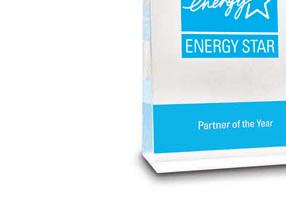







• Exclusive Vitraglas® tank lining with Microban® antimicrobial technology

• Five operating modes: Heat Pump, Hybrid, Hybrid Plus, Electric and Vacation

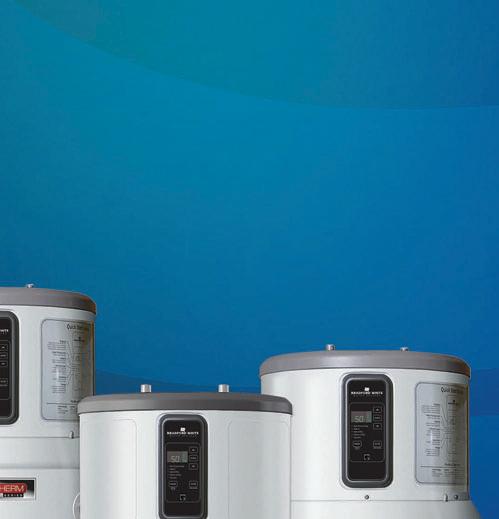
• Qualifies for local rebates*


AVAILABLE IN 50-, 65- AND 80-GALLON CAPACITIES
See why
has
the ENERGY
past
Rebates vary by region. Microban® antimicrobial product protection helps prevent the growth of bacteria, mold and mildew that may affect the product. The built-in antimicrobial properties do not protect users or others from disease-causing organisms. Microban® is a registered trademark of Microban Products Company. ©2023, Bradford White Corporation. All rights reserved. BWPLHV0523
Bradford White
been
STAR® Partner of the Year for the
4 years! *
AeroTherm®
Heater Surpasses Expectations: Visit bradfordwhite.com/heat-pump-canada
The
Series Heat Pump Water
n Industry News
2023 Federal Budget “falls short” for construction businesses
By Leah Den Hartogh
The 2023 Federal Budget fell short for the construction industry and needed to include more employment opportunities for the HVAC/R trades. The budget, which was released on March 28 by Chrystia Freeland, deputy prime minister and minister of finance, largely focused on the electrifying of the grid rather than on consumer incentives for going net-zero.

“Canada’s construction industry is ready to become a leader in the transition to a net-zero economy and is optimistic about the promised investments in green building and innovation,” reports the Canadian Construction Association (CCA) in a press release. “The focus of this budget failed to recognize that the construction industry is a key player in achieving Canada’s net-zero targets, providing employment opportunities and building the infrastructure that Canadians rely on every day.”
According to the 2023 Budget, the scale of investments that Canada requires to reach net-zero by 2050 is significant, with estimates ranging from $60 billion to $140 billion per year on average. “It will be up to the private sector to make the majority of these investments, but to avoid the consequences of underinvestment, it is critical that governments invest in policy frameworks capable of mobilizing private capital,” states the budget.
Canada is looking to clean electricity as one way of achieving its 2035 decarbonization goals in the 2023 Budget.
The investment tax for clean electricity will see a 15 per cent refund for eligible investments. This will include nonemitting electricity generation systems (wind, concentrated solar, solar photovoltaic, hydro, etc.), abated natural gas-fired electricity generation, stationary electricity storage systems that don’t use fossil fuels in operation, and equipment for the transmission of electricity between provinces and territories.
These investments in clean energy were welcomed by Efficiency Canada, but the
association still felt like the budget could have included more in terms of support. “We are concerned no new investments in energy efficiency were included in this budget, let alone support for low-income families struggling to meet their energy needs.”
The association also reports that Jonathan Wilkinson, minister of natural resources of Canada, said the government is actively considering a program that removes upfront costs for low-income Canadians across the country, which would make the oil-toheat pump program a first step towards decarbonization.
Workforce development
The Heating, Refrigeration, and Air Conditioning Institute of Canada (HRAI) was disappointed that there was no reference to workforce development investment. “Notably absent from the budget, however, are the kinds of investments in HVAC/R workforce development that HRAI has been championing for several years,” shared Martin Luymes, vice president of government relations for HRAI. “The HVAC/R industry is in need of financial support to help transition workers to the rapidly growing needs of the low-carbon economy. Without these supports, the industry will be unable to meet the government’s ambitious timelines.”
There were some welcome, important investments as part of the budget, according to HRAI. This included $500 million over
Continued on page “17”
www.plumbingandhvac.ca May/June 2023 – Plumbing & HVAC 15
The 2023 Federal Budget was released on March 28.
WHENEVER PIPING IS INVOLVED

Continued from page “15”
10 years to the Strategic Innovation Fund to support the development and application of clean technologies in Canada. Additionally, the clean technology investment tax credit will remain as the phase-out is delayed to 2034.
The clean technology investment tax credit has also expanded and will now include geothermal energy systems that are eligible for capital cost allowance Classes 43.1 and 43.2.
Money back in your pocket
The tradespeople tool deduction will be doubled, according to the 2023 Federal Budget. “It is good news that this deduction will double from $500 to $1,000, allowing tradespeople who provide their own tools as part of their employment to cover rising costs,” reports the Canadian Federation of Independent Business (CFIB). This change would take effect for the 2023 taxation year and would reduce federal revenues by $11
million over six years, starting in 20222023.
“Our economy depends on skilled tradespeople. From electricians, to painters, to plumbers, supporting Canada’s skilled tradespeople is essential to attracting more Canadians to the trades, and ensuring that Canada has the skilled workforce required to build Canada’s clean economy and double the number of new homes that will be built in Canada by 2032,” according to the budget.
Moving forward, the Canadian economy is expected to experience a bit of a slowdown, according to a letter sent to the industry by the Canadian Institute of Plumbing & Heating (CIPH) and the Mechanical Contractors Association of Canada (MCAC).
There is a clear expectation that Canada will experience a small, short-term recession later in 2023 with a return to growth in early 2024. Canada’s economy is now 103 per cent the size it was prior to the pandemic, with a record high of 80 per cent of Canadians, aged 15 to 64, participating in the workforce.
Debt relief
According to CFIB, small businesses have one major thing to celebrate coming from the budget — credit card fee reductions. “The biggest win in the 2023 budget is the deal reached with Visa and Mastercard to reduce credit card fees for small business owners,” said Dan Kelly, CFIB president. “A 27 per cent reduction in small business merchant fees is significant, but more details are needed to determine how many small businesses will benefit from this plan.”
However, the budget still missed an opportunity to provide relief to small businesses facing massive debt loads and cost increases, reports CFIB. “We were disappointed by the lack of meaningful debt relief for small businesses in the budget, when more than half are still carrying pandemic-related debt at an average of $105,000,” said Kelly. “An extension to the Canada Emergency Business Account (CEBA) loan repayment deadline of Dec. 31, is desperately needed and will be a major priority for CFIB in the weeks ahead.”
Carrier poised to acquire Viessmann
Viessmann Climate Solutions is expected to be acquired by Carrier within the next six to eight months. The announcement was leaked on April 24 but was officially announced to Viessmann leadership on April 25.
Viessmann will continue to operate under its brand and will become a significant shareholder of Carrier, with Max Viessmann, CEO of Viessmann Group, sitting on Carrier’s board of directors. The ownership transition is expected to be completed by the beginning of 2024.
“This is an exciting opportunity for Viessmann and Carrier as they work together to continue to grow in the HVAC market globally,” shared Jerry Leyte, president and general manager of
Viessmann Canada, in an email to the press.
According to the letter sent to Viessmann staff by Max Viessmann and Thomas Heim, CEO of Viessmann Climate Solutions, the acquisition will help Viessmann Climate Solutions grow its foothold in other markets, such as in Asia, and it’ll help Carrier grow its reach into the European market.
The climate solutions executive board and leadership team of Viessmann Climate Solutions, led by Heim, will continue to run the business. With the acquisition, the Viessmann Group will become one of the largest shareholders in Carrier, reports Viessmann.
All Viessmann Group businesses outside
the Climate Solutions business area will not be affected by the acquisition and the Viessmann Group will continue to remain an independent family business, according to Viessmann.
“Building on a traditional legacy of 106 years, it will further remain in full ownership of the Viessmann entrepreneurial family. The Viessmann Group will continue its entrepreneurial activities following its purpose of cocreating living spaces for generations to come. Going forward, it will be building an ecosystem that will focus on CO2 avoidance, CO2 reduction and CO2 capturing, beyond the HVAC sector,” reports Viessmann and Heim in their letter.
www.plumbingandhvac.ca May/June 2023 – Plumbing & HVAC 17 n
Industry News













Shower controls
Kohler, Milwaukee, Wisconsin, introduces its new Anthem digital control, which customizes showering. It allows for the control of up to six shower outlets, temperature, and flow. There is an optional built-in eco mode that allows for water conservation. Nine user-definable presents let each person save their favourite shower setting. It can be used with the Kohler Konnect app and features a warm-up and pause feature. The digital control board includes an optional flow restrictor, limiting total flow to 1.75 GPM. It requires an Anthem digital thermostatic valve, which is sold separately. Kohler www.kohler.com

Single-handle bathroom faucet
Delta Faucets, Indianapolis, Indiana, introduced its latest single-handle bathroom faucet to market.

The Galeon Bath Collection offers faucets with diamond seal technology, which is a patented design that reduces leak points, and decreases installation time. Its lumicoat finish makes the faucet easy to clean without the need for cleaners or chemicals. Everything needed is packaged together, including integrated InnoFlex PEX supply lines. It requires 3/8-inch compression fittings. Delta www.deltafaucet.ca
Touchless diaphragm flush valve


American Standard, Mississauga, Ont, unveiled its new Ultima Selectronic Touchless Diaphragm Flush Valves, designed to reduce maintenance, downtime and save water. The commercial valves are equipped with advanced technology, including a programmable Selectronic infrared sensor for reliable hands-free operation and optional Selectronic remote control. The valve offers two power options — a five-year battery or hardwired AC. With Multi-AC, a single power supply can run 15 faucets and/or flush valves simultaneously. American Standard www.americanstandard.ca
Bath kit
Oatey, Cleveland, Ohio, launched its Dearborn True Blue Bath Kits, which provides integrated locking features to reduce the number of tools needed for installation.
Traditionally, installers must attach the overflow (on the tub side) using screws and a brass yoke. The Dearborn True Blue Bath Kit with a clockwise turn for overflow cover installation eliminates that step. The kit includes champagne bronze, brushed gold, matte black, chrome, white, brushed nickel, and oil-rubbed bronze finishes. Oatey www.oatey.ca

Mixing valves
Watts, North Andover, Massachusetts, debuted its LFUSG-HWP Under Sink Guardian 3/8-inch compression-fitting thermostatic mixing valves, which can maintain and limit hot water to a desired selectable temperature between 27 C and 49 C. The valves feature a hot water by-pass lever with flow rates as low as 0.25 GPM and 2.25 GPM. The LFUSG-HWP incorporates dual check valves to protect against cross-flow and integral screens to filter out debris. The valves are ASSE 1070 listed, CSA certified and lead-free. Watts www.watts.com

Rain shower experience
Pfister Faucets, Mississauga, Ont, introduced its new 10-inch round showerhead. The showerhead is an all-metal construction and features a rain spray. It has a GPM flow rate of 1.8 and meets or exceeds EPA WaterSense Standards, which reduces water consumption by 30 per cent. The showerhead is part of the Tenet collection, which offers fixtures that sit tightly flush, allowing for crisp lines and a tidy footprint. Pfister Faucet www.pfisterfaucets.com
www.plumbingandhvac.ca May/June 2023 – Plumbing & HVAC 19 n Bath
By Francesco Lo Presti
Technology is ever-changing; homes are becoming way more connected than ever before. From smart televisions to smart thermostats, smart technology is quickly becoming essential in our everyday lives. More and more homeowners are looking to upgrade their bathrooms, and a recent report shows that the global smart bathroom market is expected to grow from 5.8 billion USD in 2020 to 14.8 billion USD by 2025.
Themarketisshowingprogress,butsomeelementsarestillhinderingitfromtakingoff. “Overall, there is still a lack of knowledge about smart bathroom products in the general consumer.The young but growing market is still looking for the real, everyday value in providing smart products in this space in the home,” said Ashton O’Toole, senior product manager at Kohler.
A smartphone or tablet now controls most homes, and a bathroom is no different. Whether it’s controlling the temperature of the shower, turning on music or lighting up the room with a smart lighting system, bathrooms are becoming the centrepiece of smart technology. “Since 2020,interestinsmarthomeproductsacceleratedastechnologybecameanecessarycomponent ofeverydaylife.Withpeopleworkingandspendingsomuchtimeathome,theneedfor smarter and cleaner spaces was more relevant than ever before. Thereforepeoplesoughtproductsthat made everyday tasks cleaner and easier,” explains Anny Ang, director of wholesale marketing for Moen Canada.
20 Plumbing & HVAC – May/June 2023 www.plumbingandhvac.ca
n Bath
Homes are becoming more connected than ever and it seems that the bathroom is the new hub for interconnectivity.
Understanding the technology
Some elements might be hindering why homeowners aren’t pulling the trigger and investing in water-saving technology. One of the main ones is the current market’s product price point. “The market currently has higher price point products, and it makes it easy for a consumer to cut the project price by picking the lower costing, non-smart product. There has to be the right balance of value added for the smart technology versus the cost of the product, which is still being looked for across the market,” said O’Toole.
To fully appreciate the benefits of a smart bathroom, homeowners first need to understand the technology; this can come from them doing their research, but it also falls on the contractors installing the products. “When working on a smart bathroom, contractors need to have a good
understanding of the technology being installed, including the proper installation and programming of devices such as smart showers, toilets, or faucets,” explains Parniian Frozan, brand manager for Grohe, American Standard, and DXV Smart bathroom projects now require the contractor to have additional knowledge in areas they usually wouldn’t have to worry aboutas,“Workingonasmartbathroomoften requires coordinating with an electrician to run the electrical setup needed for something likeasmartshowerortoilet.Historicallythese productsdidn’tneedelectricalconsiderations, butnowitisakeypieceofinstallationsneeds,” said O’Toole.
Angadds,“Contractorsshouldconsiderthat some customers may prefer integrated systems over single-room solutions, so contractors must take into consideration interoperability
Smart showers have seen an increase in popularity as it is oftentimes referred to as a sanctuary for homeowners.

Photo provided by Grohe
within the bathroom, and really how it correlates to the entire home.”
Ensuring products are compatible with a home’s entire system is essential when utilizing smart technology, primarily when, “Smart bathroom products are also known to be installed in places that inherently don’t have a strong Wi-Fi connection. Smart products still need a strong internet connection to work, so it is important to do a Wi-Fi test in the space before installing. You want to make sure the space will be able to support the bandwidth needed for the products,” said O’Toole.
When installing the products, contractors should make sure they stick to the instruction manual and, if there are any concerns, contact the manufacturer or the wholesaler.
Frozan also adds, “There are specific codes and regulations in the residential bathroom sector that vary by jurisdiction. These may include requirements related to plumbing, electrical, ventilation, and accessibility, among others. Contractors and designers need to be aware of these codes and regulations to ensure compliance and safety.”
Toilet time
“The current market for smart residential bathrooms is growing, with an increasing demand for smart bathroom technology that offers convenience, sustainability, and enhanced user experience," explains Frozan. “Consumers are increasingly looking for smart showers, smart toilets, smart faucets, and other IoT-enabled devices that offer
Continued on page “23”
www.plumbingandhvac.ca May/June 2023 – Plumbing & HVAC 21





















































Continued from page “21”
features such as temperature control, water efficiency, personalized settings, and connectivity.”
Smart toilets are one of the products that are starting to rise significantly in popularity. Smart toilets can offer homeowners a variety of features like automatic flushing, a heated seat, and an automatic open/closing feature. Ang adds that “Smart toilets help offer homeowners a more efficient way to use and conserve water as they can help optimize water and electrical energy usage. For example, sensing water requirements for flushing can help reduce the amount of water used compared to a conventional toilet.”
All three manufacturers referenced in this article highlighted how bidets had become a significant feature of smart toilet technology that is rising in popularity, which isn’t necessarily surprising as the world went through a toilet paper shortage at the height of the pandemic. Bidets allow users to cut down on toilet paper use.
Andrew Van Gorden, product marketing manager at Kohler, adds that “Smart toilets
“Showers are often the wellness sanctuary of the home, and homeowners are moving to smart showers, and we are now seeing a strong increase in adoption,” explains Tom Sindelar, marketing manager of performance showering at Kohler.

According to a report titled, “Smart Show Market Size, Share and Trends Analysis by Application,” North America accounted for the largest revenue
and smart bidet seats have seen a sharp increase. Starting in 2020, the trend has since continued as consumers in the market have adapted and welcomed new technology and methods of personal cleansing.” Market Research Future reported that the smart toilet market is expected to reach a valuation of 22.2 billion USD by 2030.
Singing in the shower
Smart shower technology has been in the industry now for some time, but interest in the technology has not slowed down.
share of 39.5 per cent of the global smart shower market in 2022. This report goes on to add that the global smart shower market size was valued at 1.11 billion USD in 2022 and is expected to expand at a compound annual growth rate (CAGR) of 11.8 per cent from 2023 to 2030.
Smart showers allow users to set desired water temperature and pressure, and create an immersive experience with LED lighting.

Sindelar mentions, “For showering, there are specific codes we must adhere to from a manufacturing standpoint. The codes and
regulations on the installation side are very similar to a mechanical valve installation. Installers should always consult the codes and regulations in their market to confirm anything specific to their situation.”
Water preservation
Water efficiency and conservation have become a point of interest to the homeowner and as such, technology has attempted to limit the amount of water required, while preserving comfort. “Homeowners are increasingly concerned about water conservation and looking for bathroom products that help reduce water usage. Smart water assistance products, such as smart faucets and showerheads, have been gaining popularity as consumers are looking for ways to improve water efficiency, reduce waste, and enhance convenience,” said Frozan.
While more homeowners are starting to familiarize themselves with water-conserving practices, Ang mentions there is still room for growth. The Moen 2022 Water Perception Survey reported that Canadians have good intentions but can falter when it comes to execution. For example, 91 per cent of respondents to the survey stated that saving water is very or somewhat important to them; however, only 39 per cent installed some type of water-saving faucet or showerhead. :
www.plumbingandhvac.ca May/June 2023 – Plumbing & HVAC 23
n Bath
Make sure to conduct Wi-fi tests prior to installing smart technology as range extenders might be required for the smart technology to function properly.
Photo provided by Moen
Smart toilets are on the rise and offer homeowners the benefit of cutting water consumption.
Photo provided by Kohler
When
working on a smart bathroom, contractors need to have a good understanding of the technology being installed, including the proper installation and programming of devices such as smart showers, toilets, or faucets.
FLASH FORWARD
American Standard Takes the Flash Valve Next Level


The Flash 2-Handle Integrated Shower Diverter Valve allows for the easy exchange between water outlets.

•A Simplified System
•Versatile Installation
•Compact Design
•Solid Brass Connections
•Coordinating Trims
•Double Ceramic Technology
•150° Comfort Range
Discover the easiest way to deliver everyday showering enjoyment at americanstandard.ca/flash
n Kitchen Products
Granite sink
Franke Kindred, Barrie, Ont, launches its new line of Maris Granite sinks. The Maris Granite line of sinks is manufactured with Sanitized technology, which incorporates silver ions within the material, to reduce bacteria and microbe growth. It also comes in seven hues, offers more useable bowl space, and offers a full collection of 161 models in various cabinet sizes – including single bowl, double bowl, bar, ADA and utility/laundry sinks. Franke Kindred www.franke.com
Moen Smart Water App


Moen, Oakville, Ont, debuts the Moen Smart Water App, which allows homeowners to use hand motions to control the temperature of their water and set their own default temperatures. With the app, customers can swipe left for hot, right for cold, down for warm, and push toward the faucet to turn it off.
As the temperature changes, the faucet’s LED indicator will change from blue to purple to red to visually indicate the water temperature. The Smart Water App also comes with voice control, customizable presets, and manual control with a handle.
Moen www.moen.com
Kitchen faucet spare parts


Grohe, Mississauga, Ont, unveils its Touchless FootControl retrofit set, which provides customers with a touchless kitchen faucet that can be turned on and off with a gentle tap of the foot. The unit activates water upon contact by foot with a sensor. The Touchless FootControl operation is powered via a replaceable CR-P2 six-volt lithium battery and is factory-set, providing an automatic safety stop that halts water flow after 60 seconds. A wide range of Grohe pull-out or pull-down kitchen faucets can convert into a handsfree model with this retrofit set.
Grohe www.grohe.com








www.plumbingandhvac.ca May/June 2023 – Plumbing & HVAC 25
PROMOTION
















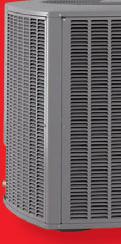



















AT ECCO SUPPLY™
SPRING
RUNS DURING THE MONTH OF MAY & JUNE 2023
supplies last PROMOTIONS SERVING THE HVAC AND RELATED INDUSTRIES SINCE 1960 ECCOSUPPLY.CA Get Rebates, Rewards, & Resources Air ConditioningHeat PumpsFurnaces & much more! LEARN MORE www.eccosupply.ca/spring-promos/
While
By Glenn Mellors
The Greener Homes Grant was launched by the government of Canada in May 2021. That means that we have two full years of data to look back on to determine the efficacy of the program. The end goal of the program was to help create a country of net zero or near net zero housing for the future.

In Canada, buildings, including homes, account for 18 per cent of Canada’s greenhouse gas emissions, according to the federal government. “Every efficient retrofit is an important component of Canada’s commitment to reaching net-zero emissions by 2050 while creating good jobs in every region of the country,” reports the government of Canada. It has a seven-year timeline, which means we are still very much in its infancy.


Getting to net zero



The end goal is set to be accomplished by reducing, to the point of elimination, the use of carbon-producing energy sources for indoor climate comfort.
Continued on page “29”

www.plumbingandhvac.ca May/June 2023 – Plumbing & HVAC 27 n HVAC
More time was needed in the lead up to the launch of the Greener Homes Grant program to make sure the industry was on track to meet its goals.
SYSTEM XFR® DWV IS RIGHT AT HOME
System XFR® DWV from IPEX is an engineered PVC DWV system available in diameters from 1.5” to 18”. It delivers greater corrosion resistance, flow rates and carrying capacity, and lower thermal conductivity than metal. It also has higher impact resistance, lasts longer, costs less to maintain AND weighs less than cast iron.
System XFR® DWV… fast becoming the preferred choice across Canada.





Ask for System XFR® DWV by name. Be sure to check out our entire line of DWV System pipe and fitting products.

System XFR® is a registered trademark used under license. For more information please contact 1-866-473-9462 or visit ipexna.com FOLLOW US IPEX Group of Companies
Open your IOS or Android device and scan here for more information. in a 40-storey condo building Certified for use in noncombustible construction, high buildings and air return plenums
Continued from page “27”
Additionally, it was created to produce more homes that maintain production of energy equal to or greater than its consumption.
If we take a look at the Greener Homes program, it makes sense. But there was a time before the induction of the program that should have involved more industry input and collaboration because, at this point, it doesn’t feel like the industry was set up for success. We weren’t properly prepared for what was coming down the pipe.
It should be simple enough for all new construction. The code writers can just implement an amendment that forces builders to produce homes that meet net-zero standards. To quote the illustrious Staples button, that was easy! But do the contractors possess the proper training to accomplish this goal? Do the manufacturers have the product ready for installation? New construction continues to feed the industry with homes
that don’t meet the net zero standards; a conversation for another day.
There are approximately 310,000 homes built every year nationwide. The Greener Homes initiative will capture a sizable number of these homes through building code changes; changes that seem to be moving slowly.
At the time of publication, there are 7.67 million homes in Canada, many of which are
still producing carbon. There are still homes being added to that total. According to a report on global carbon dioxide emissions, and posted on Our World in Data, Canada is one of the top producers of CO2, with an average per capita footprint of 15.6 tonnes. That is more than three times higher than the global average, which in 2017 was 4.8 tonnes per person.
The diagnosis
To achieve the expectation of the government’s objective, there needs to be a correction made to the more than seven million homes that are still producers of carbon. How is it possible to take a 50- to 75-year old home and make it net zero without tearing it down and rebuilding?
Several things can be done to help make these homes suck up a little less energy. One solution could be to tighten the envelope. The
heating and cooling load can be substantially reduced. Find where there are temperature exchanges within the home. Windows, doors, external sealing and internal duct sealing, and the improvement in insulation can lead to lower load capacities, which means that heat pumps can start to provide the entire home’s comfort requirements.

It became evident fairly quickly that many homeowners of older homes weren’t going to be able to afford the cost to make their homes near net zero. Oftentimes it could cost somewhere in the neighbourhood of $40,000.
Interest-free loans
The Greener Homes Grant was founded to allow all homeowners some assistance in advancing their homes to a closer state of
Continued on page “31”
www.plumbingandhvac.ca May/June 2023 – Plumbing & HVAC 29 n HVAC
The Greener Homes Grant program has a portal on its website that allows contractors or homeowners to search for each and every product that is eligible to receive a rebate.
The Greener Homes initiative will capture a sizable number of these homes through building code changes; changes that seem to be moving slowly.
Central-Moov Matched Coil Add-On System



DESIGNED FOR THE CANADIAN CLIMATE AND CONSUMER GRANTS!



The Central-Moov NEEP and AHRI listed add-on heat pump system consists of a Moovair M20 condenser and matched Moovair A-coil meets the NRCan ccASHP and Canada Greener Homes Grant requirements.









-30°C*








Up to 20 SEER



MASTER.CA VISIT COMPRESSOR & PARTS YEARS
* No LTCO (Low Temperature Cut Out) From 69 to 76% of rated heating capacity at -30°C. Refer to capacity tables for more information. Pending
grant up to $5,000
for
Continued from page “29”
net zero ability. Grants that would cover large portions of the cost of windows, doors, sealing, insulation, and HVAC were all put into place. Topped off by an opportunity to obtain interest-free loans.
The intentions behind the program were admirable, but there are many pitfalls too that have occurred over these past two years. There is a surplus of training available but there needs to be more geared towards the technology that can be utilized under this program. There are still plenty of HVAC contractors that believe that heat pumps have no place in this country. Many contractors to this day are still selling carbon-producing equipment and lower SEER air conditioners, which lock consumers into energy expenses they may no longer be able to afford. It’s important to remember that a system typically has a life span of 12 to 15 years.
Consumer education
The lack of education at the consumer level puts the industry at a disadvantage. Large question marks around how to apply and what types of products qualify are still a leading cause for hesitation at the homeowner, contractor, and manufacturer levels.
Under the current setup, the Greener Homes Grant doesn’t extend rebates for rental equipment. I can understand why providing a significant cash rebate on something that isn’t owned by the homeowner wouldn’t qualify.
Provinces that decide not to price pollution are put into the system the federal government created. Currently, the federal fuel charge only applies in Ontario, Manitoba, Yukon, Alberta, Saskatchewan, and Nunavut.

On the other hand, companies that are built on renting parts of the mechanical room just had their lunch taken away from them by a program that didn’t consider the impact it would have.
For manufacturers, there was little lead time given to produce the products needed to fill the orders. To compound the situation, manufacturers were banking on a 13 to 14 SEER air conditioning market, filling their barns full of unwanted products.
Not only that, but the program has been wreaking havoc with home improvement loan companies. Consumers are having to look for ways to access interest-free loans through the Canada Mortgage and Housing Corporation. The biggest flurry is on deferral loans to get the projects underway and pay off the higher-interest loans with the no interest government loans.
In 2022, the federal carbon price was $50 per ton of carbon dioxide. This price will continue to increase until it reaches $170 a ton in 2030.

Workarounds
Lack of available equipment is forcing consumers into installing another central air conditioning unit,
which completely deflects away from rebates and energy savings for another 10 to 12 years. Some rental companies have found a workaround by promoting furnaces and air conditioners by offering either a gas option or buying a qualifying heat pump.
There is plenty of time left within the program's lifespan for the government to conduct more industry-led discussions concerning the Greener Homes Grant program. Today sounds like a good day to start. :
Glenn Mellors was born into a plumbing family and started in the industry in 1973. He entered the HVAC side of the business in the 80s, working in wholesale, and then joined Lennox in 1992. In 2008 he joined the ClimateCare Cooperative Corporation, an Ontario contractor group, where he is director of training and implementation. Glenn can be reached at gmellors@climatecare.com.

www.plumbingandhvac.ca May/June 2023 – Plumbing & HVAC 31 n HVAC








800.526.0288 | sales@aerco.com Benchmark® Platinum condensing boiler & SmartPlate® EV indirect water heater Maximizes energy efficiency and reduces peak design load Lowers installation costs - less venting and gas connections required Saves space with ultra-compact footprint Streamlines startup and operation with direct two-way communication between units, enhanced diagnostics and configuration capabilities Boost Efficiency and Savings with AERCO’s Combination Plant Learn more at aerco.com/combination
n Tools & Instruments
Cordless threading
Milwaukee Tool, Milwaukee, Wisconsin, introduces its all-new cordless threading machine. The pipe threading machine is ideal for use with Milwaukee’s new line of universal pipe threading dies and is compatible with other universal style dies. It features a collapsible cart and is built with gas springs to assist the tool up to working height. When moving the machine, the self-contained oil reservoir keeps oil within the basin and eliminates the need to drain the oil. For jobs requiring threading and grooving, the machine’s rear hammer chuck enables a quick transition and connection of roll grooving attachments without teardown or use of additional adapters. It can thread up to two-inch black iron pipe, stainless steel, rigid metal conduit, and more.
Milwaukee Tool www.milwaukeetool.com
Video inspection solution

Teledyne Flir, Wilsonville, Oregon, launches its newest videoscope series, the Extech HDV700. The videoscope is ideal for automotive, building inspection, plumbing, manufacturing, and HVAC technicians. With a selection of eight maneuverable probes, professionals can inspect difficult to reach areas with the use of one hand. Each kit is complete with an HDV700 videoscope screen, camera probe (model dependent on kit ordered), 32 GB micro-SD card, USB-A to USB-C cable, HDMI type A to type D cable, li-ion rechargeable battery, and universal adapter.
Teledyne Flir www.flir.com
Vacuum pump
Navac, Lyndhurst, New Jersey, introduces the NP7DP — a dual voltage vacuum pump with expanded applications. Its features a twocylinder design and can vacuum down to 15 microns. Integrated cylinder structures coupled with forced oil circulation, assures performance. The built-in hook makes it easy to carry to a high workplace. It features a dual-stage, AC motor and weighs 26 lbs. The NP7DP vacuum pump comes with a one-year warranty.

Navac www.navacglobal.com
Drain cleaning
All-new compact press tool
DeWalt, Mississauga, Ont, introduces its new 20V Max compact press tool and several new jaw and ring press attachments for plumbers, pipefitters, and HVAC/R technicians. The new press tool provides press versatility in a compact design that allows for trouble-free pressing in small spaces. In addition to the compact press tool itself, new attachments allow for pressing pipes larger than 1-1/4 inch. The press tool is ideal for work in overhead and one-handed press applications. Onboard design features include a 180-degree rotating head, an LED light, Crimp Connect software to generate data from successful press cycles, as well as Tool Connect software.

DeWalt www.dewalt.com
Ridgid, Elyria, Ohio, announces its new FlexShaft drain cleaning machine. The Ridgid K9-12 features a fully enclosed housing, which contains 30-ft. of FlexShaft cable, encapsulated in nylon sheath. It is ideal for pipes that are 1-1/4inch to two-inches in diameter. The FlexShaft cable is spun by attaching a cordless drill to the input shaft on the housing. As the cable spins, the chain knocker attached will expand to provide wall-to-wall pipe cleaning. It can clean soft blockages, build-ups, and grease in sinks, tubs, showers, urinals, and floor drains.

Ridgid www.ridgid.com

www.plumbingandhvac.ca May/June 2023 – Plumbing & HVAC 33
Math doesn’t have to be difficult unless we make it so. If we struggle to understand or grasp a particular topic, it often reflects more on the instructor than the subject itself. Personally, I had a strong dislike for math during my school days. I vividly recall my math teacher asserting that I would never amount to much without his calculus class. Needless to say, I proved him wrong.
While I may not be on the same level as some of my peers, I am far from sitting on the sidelines. As Martin Luymes, vice president of government relations at the Heating, Refrigeration, and Air Conditioning Institute of Canada (HRAI), rightly points out — math would be more enjoyable if it
By Michael Ridler
were made more relevant to real-world applications.
Instead of focusing solely on abstract concepts like solving Pi, why not prioritize
teaching practical skills such as calculating GPM and flow velocities? With that in mind, as someone heavily involved in hydronic design work, I believe it’s crucial to discuss some essential formulas and share simple “hacks” that make field calculations easier.
It’s important never to shy away from math and, more importantly, not to ignore it. Just because a designer has performed the calculations doesn’t mean they are always correct. Those of us involved in design work greatly appreciate installers who double-check and validate our designs. It’s a collaborative effort, and even though your training may be less formal, your years of experience hold as much, if not more, weight

34 Plumbing & HVAC – May/June 2023 www.plumbingandhvac.ca n Hydronics
Just because the calculations have been already completed by a designer doesn’t mean that the math shouldn’t be double checked, and looked over one final time.
Oftentimes considered the least expensive part of the project, determining the required amount of radiant floor tubing is a critical step.
Photo provided by Cordes Enterprise
than that of the designer (speaking from personal experience in both installation and design work).
For this session on hydronic math, let’s consider a 2,000 sq. ft. house with a total load of 54,000 btu/h. Our goal is to heat this house using a boiler and a radiant floor heating system. Let’s dive into the math and demonstrate how quickly we can transform this information into a comprehensive hydronic package using nothing more than a notepad.

Turning loads into flow
We know that our home has a total load of 54,000 btu/h. The simplified formula for turning your btu/h into a flow is as follows:
That 10,000 represents a 20-degree Delta T across a radiant floor heating system, which is a common Delta T we see in residential system design. When you look at any heat loss and want to get a rough idea of your flow rates for a radiant floor heating system, the easy math is to divide the total load by 10,000. So in our case, our house load of 54,000 get divides by 10,000, which is 5.4.
Let’s look at that formula and get into the details for a second. Let’s start with the somewhat complete formula and work our way to the simplified formula.

The choice of Delta T can vary, but my

personal preference is always a Delta T of 20 degrees or less. Some may opt for a 10-degree Delta T (such as applications where you have a lightweight overpour with ceramic tile to minimize temperature fluctuations), which is acceptable. However, it is crucial to avoid using a super wide Delta T in your hydronic design for a building as it can lead to uneven heating and discomfort in the space.
The value of 500 is a simplified approximation used in the sensible heat rate equation for water. It should be noted that this value is not applicable to systems that incorporate glycol, and it also changes with variations in water temperature and density. Nevertheless, for our purposes, it is more than accurate enough. Now, let’s substitute the Delta T with the previously mentioned 20-degrees and observe how our formula is transformed.

Calculating the amount of radiant tubing
When it comes to hydronic design, determining the required amount of radiant floor tubing is a crucial step. One important consideration is that the piping component is often the least expensive part of the project. By installing more tubing, you can futureproof your design as the industry transitions from boilers to heat pumps. You can even use a simple calculation to demonstrate this point by multiplying your total square footage by the value in my table for the tube spacing you have selected.
For instance, let’s take a 2,000 sq. ft. home where I want to maintain an even temperature at a low water temperature. In this case, I’ll opt for a nine-inch spacing between the tubing. Using the formula, I calculate the required tubing length as follows — 2,000 sq. ft. multiplied by 1.33, which equals 2,660 ft. of pipe.
Some installers and designers still use 12-inch spacing or even 18-inch spacing.
Continued on page “37”
www.plumbingandhvac.ca May/June 2023 – Plumbing & HVAC 35
Determining the required number of manifolds is a straightforward process. Photo provided by Cordes Enterprise

Continued from page “35”
However, with an 18-inch spacing residential tubing job, the solution often involves increasing the boiler temperature, leading to higher monthly operating costs.
Caution is essential as we approach the era of hydronic heat pumps. Adjusting water temperatures arbitrarily on equipment can result in increased maintenance or even catastrophic failures. Additionally, in other webinars, I’ve demonstrated how choosing to save $500 on tubing can add hundreds of dollars to monthly operating costs. Let’s consider our 2,000 sq. ft. home again. If we calculate it with 12-inch tubing, the result is 2,000 multiplied by 1, which equals 2,000. Assuming a cost of 50 cents per foot for PEX pipe, the project with 9-inch spacing costs $1,330, whereas the house with 12-inch spacing amounts to approximately $1,000.
Calculating manifolds
Now that we have determined our total home load to be 54,000 btu/h and the required flow rate of 5.4 GPM, let’s move on to calculating the number of manifolds needed for our system. Additionally, since we are using 9-inch spacing, we know that we will require 2,660 ft. of tubing.
Determining the required number of manifolds is a straightforward process. Assuming we are using half-inch tubing, which is commonly used in 90 per cent of residential hydronic systems, we can simply divide the total tubing length by 300. This value of 300 represents the maximum length specified by the CSA B214 standard for halfinch PEX tubing.
You might wonder why we are suggesting the maximum length of 300 right away. The reason is that the CSA B214 standard allows for a buffer of +10 per cent, meaning the actual maximum length per half-inch circuit is 330 feet. In our case, we will divide the total tubing length of 2,660 ft. by 300, resulting in
approximately 8.86 manifolds. Of course, it’s not practical to have fractional manifolds, so this means we will have 8 circuits that are 300 feet long and one circuit that is shorter. Consequently, we will need a total of 9 manifolds for our system.
Calculating header pipe sizing
velocity for water in a copper tube system is five to eight ft. per second (FPS) for cold water systems, four to five FPS for hot water systems below 140 F, and two to three FPS for hot water systems with a temperature exceeding 140 F. Therefore, we design our heating systems around a flow rate of two to three FPS.
The minimum flow is based on two-ft. per second, while the maximum flow is based on four ft. per second. For a flow rate of 5.4 GPM, you can select either a threequarter-inch copper pipe, which will be on the higher end of the velocity range or opt for a one-inch pipe, if you prefer to be on the lower end.

However, it’s important not to oversize the piping. Choosing excessively large pipes can introduce potential issues and unnecessary coststhatyourcompetitors,whoproperlysize their systems, may avoid.
With all this information, we now have a comprehensive understanding to complete our design. We know that the load is 54,000 btu/h, the flow rate is 5.4 GPM, and we will be using 2,660 feet of half-inch PEX tubing with a nine-circuit manifold, all fed by threequarter-inch piping.
Sizing the circulator
Now that we have determined the total load, required GPM, amount of PEX tubing, and the number of manifolds, the next step is to size the header piping that feeds the radiant manifold. In this article, we will assume that the manifold is in the mechanical room and copper piping is used for the supply.
When sizing copper piping, it is crucial to consider flow velocities. Maintaining the recommended maximum velocity is important to prevent noise and potential long-term system issues.
As per the Copper Development Association, the suggested maximum
The next step in our process is sizing the circulator,whichrequiresknowingthesystem pressure drop. I learned a simple trick from my close friend Dave Holdorf at Taco, which provides a reliable estimation of head loss in most cases. If you’ve completed the previous step of properly sizing your header pipes, you’ll be amazed at how accurate this basic formula can be compared to a long-form calculation.
In our scenario, where the manifold is in the mechanical room and we have a short 20-ft. of three-quarter-inch copper pipe
Continued on page “39”
www.plumbingandhvac.ca May/June 2023 – Plumbing & HVAC 37 n
Hydronics
Superior Performance for Mission Critical




Viessmann’s commercial offerings for new construction and retrofit applications
Installations More information
made easy Download Viessmann‘s ViGuide app today + Compact, floor-standing boilers with zero clearance to combustibles + Intelligent self-calibrating combustion control ensures consistently optimal combustion efficiency
High operational reliability and long service life with Viessmann’s corrosion-resistant, stainless steel Inox -Crossal and Inox-Lamellar Heat Exchangers
Perfect for Variable Primary Systems with no dedicated boiler pump required
monitoring
and
viessmann.ca smart heating solutions
+
+
+Remote
for ease of commissioning
maintenance +Exceptional warranties
Vitocrossal 200 CI2
Short Lead Times Available Now! Connectivity Ready
Vitocrossal 300 CA3B
Continued from page “37”
connecting the boiler to the nine-station manifold, we can apply Holdorf’s trick. The trick involves converting the longest pipe length into a developed length and then converting it to head loss. While Holdorf likely didn’t originate this method, he taught it to me.
For our example, the 20 ft. of copper pipe is multiplied by 1.5, resulting in a calculated length of 30. The 1.5 accounts for a worstcase scenario considering the fittings in the system. Multiplying this by 0.04, which represents four-ft. of head loss per 100 feet of properly sized pipe, gives us a final head loss of 1.2 ft. for properly sized pipe. If you were to calculate the actual head loss for 5.4 GPM flowing through a three-quarter-inch copper pipe, you would get 0.7 ft. of head, but this doesn’t include all the fittings yet.
This straightforward rule of multiplying the total pipe length by 1.5 to obtain an equivalent length with fittings, and then
But since we assumed there was no specific design in our case, let’s apply the method again. We mentioned that our longest radiant
boiler, three-quarter-inch header piping, and 2,660 ft. of half-inch PEX tubing. Additionally, we need to deliver 5.4 GPM at a head loss of 12 ft, which requires a pump capable of meeting these specifications.
The key takeaway here is not to completely ignore CAD and proper design, but rather to be open to applying effective rules of thumb to quickly assemble a material quote and estimate for a radiant floor system. These rules of thumb also come in handy when troubleshooting a system. :
multiplying it by 0.04 to calculate the equivalent head, is an effective method for estimating head loss. If you perform a proper calculation of the head loss, you will find this method to be accurate.
However, there is a slight flaw in the above calculation. The math we just performed is for the pipe leading to the manifold, and I did this intentionally for demonstration purposes. Usually, when we have a radiant design, we only need to calculate the piping head loss to the manifold, not the total head loss in the floor.
floor circuit is 300 ft. long. Since we don’t have any fittings to account for (as it is impractical to use 10-foot lengths of PEX cut-offs for a floor), we can multiply the length by 0.04 and obtain 12 feet of head. For the purposes of this article, I actually designed the radiant loop using CAD software, and after all calculations, I determined that the total load was 54,375 btu/h, with a flow rate of 5.46 GPM and a total head loss of 10.1 ft., including the header piping and the radiant floor tubing.

We now know that we need a 54,000 btu/h
Michael Ridler is a technical services manager at Eden Energy Equipment. He started out working for a Ont-based HVAC company and now focuses on providing field support and technical training to contractors, engineers, and builders on heat pumps, boilers, and all things hydronics. He can be reached at edenenergymike@gmail.com

www.plumbingandhvac.ca May/June 2023 – Plumbing & HVAC 39 n Hydronics
Installing more tubing will help future proof the design as the industry transitions to heat pump technology. Photo provided by Cordes Enterprise
It’s important never to shy away from math and, more importantly, not to ignore it. Just because a designer has performed the calculations doesn’t mean they are always correct.
AC Event is on Now!
It’s Time to Go Full Blast!

Having top AC brands, parts and accessories is our priority.































Shop your most-used Air Conditioning and Indoor Air Quality brands, and shop Greener Homes Grant eligible products to help your customers save more!

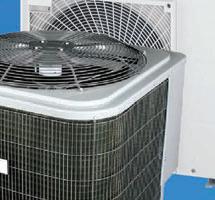


Shop While it’s Hot! Scan to shop online or visit us in-branch

n Controls
Complete building control
Honeywell, Atlanta, Georgia, launches several new products during the recent AHR Expo 2023. The Honeywell Optimizer Suite consists of a variable air volume (VAV) controller, a unitary controller and an advanced plant controller to help any existing building system. The Honeywell Remote Building Manager allows owners and tenants to monitor energy use, reduce operational costs, and manage their building’s systems 24/7 from anywhere. The TR50 Indoor Air Quality Sensor provides continuous IAQ monitoring and visual confirmation of air quality. Lastly, the Honeywell Buildings Sustainability Manager is an autonomous controls platform with a suite of applications that help customers meet carbon reduction goals.
Honeywell www.honeywell.com
Plug-and-play zone solution
Airzone, Atlanta, Georgia, announces the launch of Easyzone in North America, a plug-and-play, all-in-one zoning solution for concealed inverter and VRF HVAC units. Easyzone can regulate temperature and airflow capacity in up to six independent zones. The Easyzone ships as a pre-wired kit, including a thermally insulated motorized plenum, control board and plenum neck. Easyzone is available with either six-inch or eight-inch dampers.


Airzone www.airzonecontrol.com
CO2 monitoring
Network Thermostat, Grapevine, Texas, introduces its latest flagship model, the NetX X7C thermostat, which features CO2 monitoring and control. The NetX X7C features an internal CO2 sensor and does not require field calibration for five years. The thermostat also includes an internal expansion port for the NTMOD-ULE, creating the ability to use Dect ULE wireless sensors. Daily commercial scheduling, independent event scheduling, keypad lockout, and demand response control are included in all X7 thermostats.


Network Thermostat www.networkthermostat.com

Mini split/VRF controller
Fujitsu, West Fairfield, New Jersey, announces the Kagami controller, its new mini-split and VRF controller. The controller offers touchscreen control of Airstage H, J and V-Series systems. It features a backlit touch panel that displays room temperature when activated, along with the current time. Kagami can be customized with logos from hotels or other properties. It allows up to 16 individual Fujitsu indoor units to be simultaneously controlled from a single unit.
Fujitsu www.FujitsuGeneral.com
Single stage heating thermostat
Watts Water, Burlington, Ont, debuts its new smart and connected W561 thermostat to market. The Wi-Fi connected thermostat offers temperature control of a single-stage heating system and can be controlled remotely. The W561 features a seven-day, four-event programmable schedule and an early start feature that automatically heats up a room by the scheduled time.
Watts Water www.watts.com
Single-family controls

Uponor, Mississauga, Ont, debuts the Smatrix Pulse, a new multi-zone wireless control for radiant and air-side comfort in single-family residences. The Smatrix Pulse allows users wireless control of their radiant floor heating and forcedair heating and cooling systems. The controller can accurately measure air, surface, and floor temperatures in each zone with embedded operative sensors in the thermostats along with optional slab sensors. It can be connected to a smart home device for voice-activation control. A single controller configures up to six thermostats, eight actuators, and one remote relay using local networks. Adding an expansion module adds six more thermostats, eight more actuators, and one more remote relay to the controller. For larger residences, a controller with an antenna can connect up to four controllers and expansion modules for a total of 48 zones.
Uponor www.uponor.com
Environment controller
Johnson Controls, Milwaukee, Wisconsin, announces the release of the Metasys CCM09090 critical environment controller. The CCM09090 is a room-level controller that controls temperature, humidity and air handlers for spaces like complex labs with multiple fume hoods and healthcare facilities. The controller also features a high-definition capacitive touchscreen display and 18 communication points to equip input/output flexibility.

Johnson Controls
www.johnsoncontrols
www.plumbingandhvac.ca May/June 2023 – Plumbing & HVAC 41
By Greg Scrivener
As air conditioning season gets underway, it’s a good time to review how to measure superheat and subcooling. These two measurements are two of the most important parameters needed to understand what’s happening in an air conditioning system when either charging or troubleshooting. In simple terms, and in the context of air conditioning, superheat is above the boiling point of a substance – in our case, refrigerant.

The function of an evaporator is to boil liquid refrigerant by absorbing heat from the warmer air going over the coil. This is the same concept as a pot of water absorbing heat from the element on your stove to boil, except that in the air conditioning coil, it’s happening a lot colder, around 40 F. Once the refrigerant has completely boiled and is 100 per cent vapour, it is still colder than the air going over the coil; this means that any more heat we add to it will start to increase the temperature of the refrigerant. This increase in temperature is what we call superheat.
It’s very difficult to measure the actual temperature of the coil since it’s inside ductwork with air moving over it; instead, we use the relationship between pressure and temperature to determine the temperature of the coil. A pure fluid boils at a constant temperature for a given pressure. For example, water boils at 100 C at sea level, but at the top of Mount Everest, it boils at 68 C because the air pressure is so much lower. Similarly at sea level, R410A boils at -51 C and on the top of Mount Everest it would boil at -71 C. Explained in the opposite way, as we increase the pressure on a fluid, the boiling temperature goes up. It turns out that for R410A, if we measured a pressure of 118.4 psig in our coil, then the temperature at the evaporator coil would be 40 F.
42 Plumbing & HVAC – May/June 2023 www.plumbingandhvac.ca n Refrigeration
These measurements are two of the most important parameters needed to understand an air conditioning system.
A residential air conditioning system showing the gauge ports for measuring pressure and the piping locations where superheat and subcooling measurements are often taken.
Figure 1 shows this relationship on a screenshot from a refrigerant pressuretemperature (PT) app and schematically with a pressure measured on the suction line determining the temperature in the evaporator coil.



Measuring on the suction line
Superheat is heat that is added above the boiling temperature. On split systems, this is often measured on the suction line near the compressor, as shown in Figure 2. In this case, you can see that the temperature in the coil is 40 F and the temperature on the suction line is 55 F. The superheat is the difference between
these temperatures, which would be 15 F. There are two potential pitfalls with these measurements to pay very close attention to suction line pressure drop and suction line temperature gain. Consider a suction line that has a pressure drop of five psig. In this case, you would see what is shown in Figure 3. The pressure at the condensing unit would indicate 113.4 psig, which would lead you to believe the evaporator temperature is 38 F. With the same temperature measurement of 55 F as the previous example, the superheat would now seem to be 17 F
Similarly, there is a potential problem with measuring the temperature at the condensing unit. Since the suction line is most often colder than the ambient air temperature around it, the refrigerant gets additional superheat as it travels from the evaporator to the compressor. This temperature rise is particularly noticeable if the suction line is long or poorly insulated. Figure 4 shows how this could cause an overestimation of superheat. In this case, the actual evaporator superheat is 5 F and there is 10 F of suction line superheat.
The distinction between evaporator superheat and suction line superheat — often called useful and non-useful superheat, respectively — may or not be important to you. If you are just checking the superheat to ensure that the compressor is protected from liquid flood-back, a degree or two may not matter at all. However, if you are setting up a new air conditioner or troubleshooting, these two potential measurement errors can have significant consequences. One of the reasons these concepts are important to grasp is that many types of electronic gauges do all of these calculations for you. This can lead to a reliance on the information the gauges provide without a solid understanding of
Continued on page “45”
www.plumbingandhvac.ca May/June 2023 – Plumbing & HVAC 43
Figure 1: A screenshot of a refrigerant PT app showing R410 at 40 F and 118.4 psig, and a schematic of a residential air conditioner showing the relationship between suction pressure and evaporator temperature.
Figure 2: Pressure measurement at the condensing unit determining the temperature in the evaporator coil and temperature measurement at the condensing unit determining superheat.
Figure 3: A five psig pressure drop in the suction line is creating an error in the superheat calculation.
Canadian refillable cylinders available
Make the Switch to Solstice® N40

Solstice N40 (R-448A) offers 5-10% lower energy consumption, a 68% reduction in global-warming-potential and lower environmental impact on the planet. Solstice N40 is approved for use by all major compressor and component manufacturers, and is a near-drop-in replacement for R-404A, allowing for easier installations and conversions. Talk to us today to find out more.
For more information visit: https:www.honeywell-refrigerants.com or Call 800-631-8138

© 2019 Honeywell International. All Rights Reserved.
n Refrigeration
the condenser, the refrigerant is condensed from vapour to liquid. The process is essentially the reverse of what is happening in the evaporator but it’s happening at a warmer temperature because we’ve increased the pressure.


the air outside.
Continued from page “43”
the limitations associated with where you hooked them up. In a perfect world, you would be able to measure the superheat at the evaporator and eliminate the error caused by pressure drop and temperature rise. Some tools use Bluetooth to be able to do a remote temperature measurement, but a pressure measurement is not possible unless there is an access valve added at the evaporator outlet.
Subcooling
Subcooling is the temperature below the condensing temperature of a substance. The condenser in an air conditioner is designed to reject the heat absorbed in the evaporator and added by the compressor. In
An R410A air conditioner condensing at 110 F would have a condensing pressure of 365.5 psig. Figure 5 shows this relationship with a screenshot of the PT app and a schematic of the air conditioning system. One of the trip-ups that I see regularly is caused by the fact that subcooling is happening in the warm part of the system where superheat is usually discussed in relation to the cold part of the system. One way that sometimes helps get these straight is to realize that your hot cup of coffee is subcooled since it is below the boiling point of coffee — hot things can be subcooled.
Once the refrigerant in the condenser has completely condensed, it is still warmer than
If there is enough refrigerant in the system for liquid to back up at the condenser outlet, then the refrigerant will have a chance to cool off more. This additional change in temperature is the subcooling. Figure 6 shows the relationship between the pressure measured at the condensing unit outlet being used to determine the condensing temperature and the liquid outlet temperature. The difference between these temperatures, 10 F in our case, is the subcooling.
Subcooling measurements on residential air conditioning systems are not prone to the same errors as superheat measurements are because they are being done right at the condenser outlet.
Measure accurately
Both adding refrigerant and troubleshooting air conditioning systems properly is highly dependent on being able to accurately measure and understand both superheat and subcooling. This article has outlined the process for obtaining superheat and subcooling measurements and explained some of the errors we can see when doing them.

However, it has so far ignored the additional challenge of blended refrigerants. In the case of 400 series refrigerants (R449A, R410A, etc.), it is important to remember to use the dew point temperature from the PT chart or app to determine superheat and the bubble point temperature when calculating subcooling. If you take a look at Figure 6, you will see that the PT app I used has a slider to switch between the two. Happy troubleshooting! :
Greg Scrivener is the lead refrigeration engineer and a partner at Laporte Consultants, Calgary, and works throughout Canada and the U.S. He is a professional engineer and journeyperson refrigeration mechanic. He can be reached at GScrivener@laporteconsultants.com

www.plumbingandhvac.ca May/June 2023 – Plumbing & HVAC 45
Figure 4: The suction line temperature increase is causing an overestimation of the actual superheat.
Figure 5: The relationship between condensing pressure and temperature.
Figure 6: These measurements show the condensing temperature relationship to the liquid temperature and subcooling.
INTERNALBATTERY














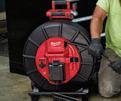



















2"6" PIPE SIZE
TO FIND OUR EMCO LOCATION
HUB
REELS
ELEVATING THE PRO PLUMBING MECHANICAL TRADE SCAN
SWAP
BETWEEN
FORHOTSWAP LINE TRACE SIMPLEST locating experience OMNI DIRECTIONAL antennas COLOUR LCD SCREEN with backlit LED buttons PIPELINE LOCATOR KIT TM CAPTURES 1080P 4X DIGITAL ZOOM OPTIMAL LIGHT OUTPUT CLEAREST IMAGE CAPTURE CREATE SHARE EASIEST INSPECTIONS 200' STIFF PIPELINE INSPECTION SYSTEM
n PHVAC in the Field
The MCEE trade show was in full swing this year in Montreal with an exhibitor’s hall full of the latest products and plenty of educational seminars.
Wolseley Toronto Expo
Over 800 people, including contractors from all across Ontario, attended Wolseley Canada’s Expo on May 11 at the Toronto Congress Centre. In The trade show floor was packed with more than 50 exhibitors in plumbing, HVAC/R, IAQ, and tools/instruments.


The show ran from 2 p.m. to 7 p.m. and allowed for plenty of networking opportunities, with food and drink tables set up around the facility, including some kettle chips that seemed to be snatched up as soon as they were put out.
The event began with an opportunity for Wolseley staff to explore the show floor before the doors opened for contractors.
Attendees were also able to attend four educational seminars, which were presented by Greenbrain and the Wolseley Tech team, Google, GE, and ADS.
Wolseley is heading east for its next trade show. The Wolseley Halifax Expo will take place on June 1st and will feature a Wolseley exclusive concert featuring a performance by Signal Hill at a post-expo private event from 7 p.m. until 9 p.m.
MCEE 2023
After a two-year hiatus, the MCEE show was back in full force in Montreal. Held from April 19 to 20, the mechanical and electrical trade show welcomed around 400 exhibitors and 7,000 guests, all occupying 65,000 sq. ft. of new products and the latest technology.

Held in downtown Montreal at the Palais des Congres Centre, guests got their hands on the newest technology and products. The show reports that 82 per cent of guests stated that they came just for the new products. The VIP reception, which was held the night before the show floor opened, showcased the winners of the New Product Competition. To see the full list, visit our website.
The show runs bi-annually and is produced by the Canadian Institute of Plumbing & Heating (CIPH), the Corporation of Master Pipe Mechanics of Quebec (CMMTQ), the Corporation of Master Electricians of Quebec (CMEQ), and Corporation des entreprises de traitement de l’air et du froid (CETAF). The show will return on April 24 and 25, 2025, at the Palais des Congress Centre in Montreal.
Ont. Skills Competition
Skills Ontario held its first in-person competition since before the pandemic and it was jam-packed with competitors, trades enthusiasts, and lots of happy faces. The event took over the Toronto Congress Centre from May 1st through 3rd. A formal closing ceremony took place on the final day of the show. Over the three days, there were an estimated 20,000 to 25,000 people walking around supporting those competing or competing themselves. A full list of this year’s winners can be found on the Skills Ontario website.
www.plumbingandhvac.ca May/June 2023 – Plumbing & HVAC 47
Bonus incentives are ending soon
Apply before June 30, 2023
Standard incentive
Earn business partner incentives for every project
$1.00/m3 natural gas saved $1.00/m3 natural gas saved
Standard incentive
$1.30/m3 natural gas saved for high-efficiency boilers and related boiler controls

incentives for non - boiler projects
Limited-time bonus incentive Limited-time bonus incentive
$1.40/m3
$1.40/m3 natural gas saved for condensing boilers and related boiler controls
$100/unit†
Custom projects such as insulation upgrades, heat recovery, control processes and other equipment and processes


$100/unit†
Condensing water heaters, condensing make-up air units (MUA) and energy recovery/heat recovery ventilators (ERV/HRV)
5%†
natural gas saved for building automation controls, ventilation technologies, variable frequency drives and other equipment and processes
of the total customer incentive per building
Custom variable frequency drives and in-suite ERV/HRV
Affordable Multi-Family Housing Program * HST is not applicable and will not be added to incentive payments. Terms and conditions apply. Visit enbridgegas.com/affordable for details. Limited-time offer up to 75 percent of energy efficiency upgrade costs, up to a maximum of $200,000 per project is available to all Enbridge Gas affordable multi-family housing customers. Contact your Energy Solutions Advisor to confirm eligibility. To qualify for bonus incentives, purchase order must be provided by June 30, 2023 and equipment installed and commissioned by Oct. 31, 2023. Incentive offers are subject to change based on budget availability. † Maximum business partner incentive of $1,000 per project. Business partner incentives are only available for qualifying projects. Visit enbridgegas.com/businesspartner for details. © 2023 Enbridge Gas Inc. All rights reserved. ENB 1502 05/2023
boilers
To qualify for bonus incentives, customers
$200,000 Customer incentives for boiler projects Customer
Whether you’re replacing
or installing make-up air units, collaborate with an Enbridge Gas Energy Solutions Advisor early on. They’ll calculate your customer’s energy savings and secure incentives for upgrades, helping customers offset upfront costs. For a limited time, we’re offering bonus incentives to cover even more project costs. Receive financial incentives for projects involving eligible high-efficiency equipment.
must commit by June 30, 2023 and install and commission projects before Oct. 31, 2023
to
Contact an Energy Solutions Advisor to get started enbridgegas.com/affordable energyservices@enbridge.com1-866-844-9994
Book now to help your customers get incentives Up
PLUS!
First ever Ont. based apprenticeship summit

Supporting the apprenticeship and certification model, promoting the skilled trades, facilitating research in the skilled trades, and building an inclusive skilled trades sector are the four pillars that Skilled Trades Ontario will be working on over the next three years. The strategic plan was announced at the government agency’s first Industry Summit on Apprenticeship, which was held at the Toronto Congress Centre on May 3 during the Skills Ontario Competition. The framework was shared with over 250 industry leaders, educators, and apprentices.
The first-ever Industry Summit on Apprenticeship was held during the Skills Ontario Competition and drew a crowd of attendees and apprentices to discuss the system in Ontario.
Guests of the summit were able to provide feedback on the strategic plan by asking questions and participating in workshops.
Hydronic training offered by Eden Energy Eden Energy Equipment hosted a “building science” training event, which featured Dr. Allison Bailes as the keynote professor. The event lasted two days and provided attendees with an insight into how a home can run more efficiently. Most of the source material for the training came from Bailes’ book, “A House Needs to Breathe… Or Does It?” As such, the presentation explored the basic science of buildings and explored the myths and misinformation that pervade the world of home building, remodelling, maintenance, and operation. The training session consisted of Bailes walking guests through three main chapters, starting from the end — the building enclosure and the mechanical systems. Around 40 guests attended both training days. In between training sessions, guests were able to walk the Eden Energy training facility and enjoy refreshments and lunch. Bailes also had copies of his book available for purchase.
Watts employees gathered together in one of the training rooms at its new Fort Worth learning centre to formally cut the ribbon and celebrate the official grand opening of the facility. It took two tries to get the giant scissors to cut through the ribbon, which led to the group laughing and uttering something about technical difficulties.
New Watts learning centre opens in Fort Worth
Watts Works opened its seventh learning centre in North America in Fort Worth, Texas. The training centre is set to train Canadian contractors on many different Watts-specific products, many of which are manufactured at the facility.


A group of trades-specific media were invited down to tour the 3,600 sq. ft. learning centre, office areas, and manufacturing floor. We were able to see Watts employees conduct robotic welding and cutting, laser metal cutting, and sheet metal rolling. At this specific facility, PVI water heaters, Blücher stainless-steel trench and HygienicPro drains, and Ames and Watts in-building risers are produced.
To commemorate the official opening of the facility, a ribbon-cutting ceremony was held.
UL 60335-2-40 RECERTIFICATION
The biggest change coming to the HVAC industry is recertification to UL 60335-2-40. Intertek can help manufacturers during the transition period.

+1 800 WORLDLAB (967 5352)

www.plumbingandhvac.ca May/June 2023 – Plumbing & HVAC 49
n PHVAC in the Field
icenter@intertek.com Intertek.com/HVACR FOR MORE INFORMATION
Dr. Allison Bailes held a building science training session at Eden Energy Equipment in Guelph, Ont. to a sold-out crowd.
NEW COMMERCIAL TOILETS & ECOPOWER® FLUSH VALVES



HIGH-PERFORMANCE MEETS EASY MAINTENANCE Available at NEXT has full stock of all TOTO products for residential, institutional and commercial spaces. Contact us and ask to speak to one of our TOTO experts for more information.





TOTO’s revolutionary new commercial toilet features its market-leading TORNADO FLUSH® system, which provides a powerful nozzle to create a forceful centrifugal, cyclonic rinsing action that reduces waste buildup and keeps the bowl cleaner.

nextsupply.ca
Martin Rego has accepted the role of director of product management at Rheem Canada . He has previously worked within the air and water industries and holds a degree in mechanical engineering from the University of Toronto. He is also a licensed professional engineer. Over the years, he participated in the development of codes and standards with the Canadian Standards Association and technical committees with the TSSA.
Armstrong Fluid Technology has named John Doughty as its new director of global sales enablement. Based in the United Kingdom, he will work with Armstrong sales teams around the world. Prior to joining Armstrong, he was the global director of sales excellence for the electrical products business within Honeywell.

Uponor North America announced that Jon Sillerud will take on the additional responsibilities of leading the supply chain function of
the company in addition to his role as vice president of operations, effective immediately. He has been filling the supply chain leadership role on an interim basis for several months. His new title is vice president of integrated supply chain.


In addition, Uponor North America has announced that Anna Picchetti will take on the role of vice president of marketing and strategy, effective May 8. In her role, she will oversee channel marketing, portfolio, analytics, sustainability, segment, engagement, brand, and communications. She will report to Andres Caballero, president of Uponor North America.

Watts Water announced that Chantel Cassel will join the team as the customer service and inside sales manager. She has over 10 years of experience in management and a background of customer service and sales.

King Heating Products announced that Wayne Kucharchuk will be the company’s new sales and marketing specialist in the prairie provinces (Alberta, Saskatchewan, and Manitoba). Kucharchuk comes with 38 years of experience in heating and hydronics.

Sonnhalter announced that Nibco will be added to its client's list. Founded in 1904, Nibco manufactures valves, fittings, and flow control products for commercial, industrial, and institutional construction, marine markets, as well as residential and irrigation markets. The company’s headquarters is located in Elkhart, Indiana.
Synchrony and LG Air Conditioning Technologies announced a new multi-year partnership offering LG’s independent Pro Dealers, a financing program to help homeowners purchase smart heating and cooling products. The private label credit card program will feature competitive deferred interest, fixed payment, and equal monthly payment promotion options.
Fujitsu partners with Intelligent Mobile Support to offer contractors Sales Builder Pro professional HVAC sales software. The app includes all Airstage H-series and Fujitsu unitary products.
Daikin Applied announced that it has acquired Carroll Air Systems, a Tampa, Florida-based company that provides heating, ventilation and air conditioning systems and services for commercial, industrial, and institutional facilities. Carroll Air Systems has
a long history within the construction and building management industry, having been involved in the development and renovation of airports, hospitals and clinics, offices, schools and other facilities across parts of Florida.
U.S. Boiler Company introduced its new USB-Connect smartphone application. The app, which interfaces with all models of Alta, Aspen, Alpine and K2 boilers through a Bluetooth adapter, allows technicians to access the boiler control via smartphone or mobile device rather than the boiler display.
Wolseley Canada donated a portion of sales to support clean water initiatives in Canada. To celebrate World Plumbing Day on March 11 and World Water Day on March 22, Wolseley Canada announces a portion of all sales from Proflo products will be donated to Water First, an organization dedicated to working collaboratively with Indigenous communities in Canada. The campaign ran the entire month of March.
Johnson Control released its 2023 Sustainability Report on May 4. The company reports accelerated progress in its own sustainability journey and in the reduction of customer emissions. To accelerate its own net zero journey, Johnson Controls is looking at the smart building trifecta of energy-efficient equipment, clean electrification, and systemic digitalization.
www.plumbingandhvac.ca May/June 2023 – Plumbing & HVAC 51 n People & Places
Martin Rego
John Doughty
Wayne Kucharchuk
Jon Sillerud
Anna Picchetti
The
Chantel Vassel
People
The
Companies
By Ron Coleman
When exiting your business, there are several choices that can be made — sell the business to a third party, sell to employees or family, or wind it down. Selling to a third party is the most desirable outcome, with less risk financially and less risk of the business failing. However, it is often difficult to find a buyer for the business; with fewer than 40 per cent of listed businesses selling, you would need to have a very attractive business to find a buyer. We have explored this topic in previous articles.
Selling to family or employees is fraught with risk. You will likely have to finance most of the purchase price and the working capital, plus you don’t really know if they have the businessacumentorunasuccessfulbusiness On that note, the federal government recently announced a new Employee Ownership Trust Program (EOT). It is something to explore if selling to employees. Usually, a transition period over a few years is the least risky approach. I often recommend a gradual buy-in approach.
If there are no suitable employees or family members, you are likely left with no option other than winding down the business You can’t just walk away from it. Unfortunately, it is easier to get into the plumbing and HVAC businesses than getting out of it.

If your work involves new construction or major retrofit projects, it becomes even more difficult.
Dipping into savings
As we wind down our business, we have to


52 Plumbing & HVAC – May/June 2023 www.plumbingandhvac.ca n Shop Management
Therearemanystepsthat needtobetakenwhen closingabusinessdownand havingadecentamountof overheadwillsetyouupfor amoresuccessfultransition.
maintain a relatively high level of overhead and have little sales to support the overhead. As a result, most of the ongoing overhead is covered by previous profits that are already in the business. That means you are going to erode your retirement fund. On projects with holdback, you must ensure you collect your holdback. Warranties are also a major issue. If your customer knows you are shutting the business down, they are more likely to want to hold back funds in case of warranty issues. You will have to carry that financing and ensure you do any warranty repairs.

What about your rented premises? When is your lease going to expire? Have you done modifications that have to be reversed under the lease terms? Do you have the right to sublease? When do you start selling your equipment, vehicles and surplus inventory? When do you tell anyone that you are closing down the business?
Jumping ship
I have already mentioned some of the issues with customers and here is one more – they won’t award you any future work if they know you are not going to be around to
have met all your trust responsibilities. Don’t leave the Canada Revenue Agency out in the cold, they don’t like it! Close down all your CRA accounts, payroll, GST/HST and corporate taxes. Remember to keep your records for six years in case CRA comes looking. Also, shut down any provincial tax accounts. Clear everything that has a personal responsibility and close all supplier accounts and get any personal guarantees to suppliers or other parties cancelled. Cancel all credit cards that were used for the business to ensure that no purchases are made by former employees or others who might have accessed the card numbers. Also, close all contracts and leases, don’t forget to cancel cell phones and annual subscriptions. If you have software on a lease program, cancel it but back up your data first.
One option for getting paid out on holdbacks or where extended warranties are involved is to get your bonding company to issue a bond to cover the holdback or the warranty period. Insurance policies can also be used to cover warranties. If you can’t get a bond, get a letter of credit from your financial institution in order to have holdback released. While the client may not be legally entitled to hold monies back, it can be expensive and time-consuming to use the courts. Do read your contracts to see what rights you have.
Service work and small projects are easier to handle in a winddown. Less money in each project and shorter timelines help a great deal.
You also need to look at exposures you may have in other areas. Are you liable for any severance pay? You need to take legal advice on this to ensure you meet federal and provincial standards. Laying off longterm employees can be very expensive. There are many instances where employees receive severance packages equal to 12 to 18 months of remuneration.
provide the warranty. Once your employees find out, they are more likely to go and seek a job elsewhere and in this market, that is easy. Your supplies may also cut back on credit terms or preferred pricing and rebates. You are definitely going to need to retain some key employees to help wrap things up. A promised bonus at the end of the day will help retain them while further eating into your retained earnings.
Eventually it will be time to quit. All the money has been taken out of the company and it now becomes a shell. Should you decide to deregister it, you will need to get a lawyer to do this and make sure you get a quote as it is not cheap. I recommend that my clients stop filing annual reports. In British Columbia, if you don’t file annual reports for three years, your company will automatically be struck off. It’s simpler to file a simple corporate tax return with no activity for those three years.
Closing down accounts
To wrap up your business, ensure that you
Finally, we have closed down the operations and have some money in the bank. Usually, the company invests that money and pays a high tax rate as you won’t qualify for the small business tax rate any longer. This is a topic for discussion with your accountant as each province has different rates. If you are going to be involved in another business, maybe you decide to become a one-person part-time business. If so, run that through the corporation.
This entire process is very emotional. You have likely spent many years making the business part of your everyday life and now you are walking away from it. It is tough and you need to have good support both professionally and personally. Stay strong and practical. :
www.plumbingandhvac.ca May/June 2023 – Plumbing & HVAC 53
This entire process is very emotional. You have likely spent many years making the business part of your everyday life and now you are walking away from it.
Ronald Coleman is a Vancouver-based accountant, management consultant, author and educator specializing in the construction industry. He can be reached by e-mail at ronald@ronaldcoleman.ca.
n Coming Events
See you soon, Montreal
The Heating, Refrigeration and Air Conditioning Institute of Canada (HRAI) will be hosting its annual general meeting in Montreal for the 2023 season. Held from Sept. 17 to 19 at the DoubleTree Hotel, the two-day event will see industry members join together to discuss the next steps for an ever-changing industry.
During the meeting, participants can network, attend sessions and educational presentations, and enjoy the beautiful city of Montreal. In addition, guests have their choice of attending either a boat tour (at $95) or a brewery tour (at $125) for the first day of theconference.Additionally,atouroftheBell Centre (at $110) or the Centre for Sustainable Development (at $80) is available on the second day.
HRAIwillalsobehostingthenextmeetingof the International Council of Air-Conditioning, Refrigeration and Heating Manufacturers Associations (ICARHMA) in conjunction with itsannualmeetingandconference.
Last year, HRAI’s AGM in Ottawa focused ontheindustry’sjourneytowardelectrification and the ongoing labour shortage.
Tickets are now available, with prices running at $995 plus tax for attendees and $295 plus tax for companions.
INDEXto ADVERTISERS
MCAC heads to the vineyard
Bring your wine glasses and fancy hats because Napa, California, will be the location for the Mechanical Contractors of Canada’s (MCAC) annual conference. The conference will run from Oct. 18 to 21 at the Silverado Resort and Spa and offers its participants a variety of networking opportunities, informative discussions, and extra-curricular activities.
While the conference officially starts on Oct. 18, pre-conference activities and sessions will be held on Oct. 16th and 17th. These two days will feature private events of meetings consisting of managing councils, the MCAC board of directors, and education committees.
Day one of the conference will feature an opening breakfast and keynote speaker at 7 a.m. as the only event. The next three days will have a jam-packed schedule that includes educational seminars and networking. Sessions that can be attended during the conference include “Creating and Supporting a Diverse Workforce,” “The State of Risk Management for Mechanical Contractors,” “Implementing Fleet Management for Service Contractors,” and “Nearshoring and Inflation: How Supply
Chains have Changed and What it Means for Contractors,” all available on Oct. 19.
On Oct. 20, there will be an association meeting, an invitation-only open shop meeting, and a Women in Mechanical Construction meeting. There will also be sessions such as an economic and labour force update, creating higher value projects through government funding, and the ‘new normal’ for the mechanical contractor – how the legal landscape has changed.
The conference’s final day will feature its closing breakfast, keynote speakers, and a session titled, “FutureCasting the Mechanical Contracting Sector.” The final day will also feature the annual general meeting.
Once business is taken care of, participants and their companions will have access to multiple activities throughout the conference. There will be two golf tournaments, an inaugural two-person scramble and MCAC’s annual conference tournament, grape stomping and morning yoga.
Calendar
June 18 – 20:
CIPH ABC 2023, Delta, St John’s, Newfoundland and Labrador. For more information, please visit www.ciph.com.
June 24 – 28:
ASHRAE Annual Conference, JW Marriott Tampa Water St. and the Marriott Tampa Water St, Tampa, Florida. For more information, please visit www.ashrae.org.
Sept. 17 – 19:
HRAI Annual Conference, DoubleTree Hotel, Montreal, Que. For more information, please visit www.hrai.ca.
54 Plumbing & HVAC – May/June 2023 www.plumbingandhvac.ca Aerco .................................................32 American Standard ............................24 Bradford White - Canada Inc. .............14 CB Supplies ........................................56 Ecco Supply .......................................26 Emco ..............................................46 * Enbridge ......................................... 48 * Flocor ................................................16 Giant Inc. ...........................................25 Honeywell ..........................................44 ICP .....................................................11 Intertek ..............................................49 IPEX ...................................................28 Lyncar ................................................22 Master Group ....................................30 Navien .................................................9 NEXT Supply ....................................50* PVI ......................................................4 Reliance Worldwide Corporation ........18 Sluyter ...............................................13 Taco ....................................................36 Triangle Tube .......................................2 Viega ...........................................12, 55 Viessmann .........................................38 Wolseley ............................................40
*Ont-Only
DOWNTIME? NEVER HEARD OF IT.
Press more than the industry’s best fittings. New valves are here to complete our MegaPress® systems. You can save up to 60% on assembly time vs. welding and ditch the risky flames too. Viega Valves are approved for a wide range of applications and media. Available in 1/2" to 4" sizes.
Learn more at www.viega.ca/en/products/systems/valves.html

The Diamondback

DIAMONDBACK® CSST flexible gas piping system offers industry-leading performance with superior flow rates for both natural and propane gas (LPG*), allowing you to use smaller diameter pipes and fittings on your next project, saving you time and money!
Diamondback Flexible Gas Piping is a corrugated, semi-rigid stainless steel tubing (CSST) offering:




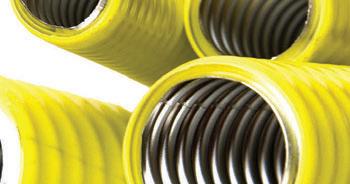






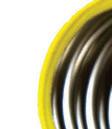












Superior Flow Rates: saves MONEY on labour and materials.













Easy-to-Install Fittings: convenient 3-Piece fitting system is QUICK and RELIABLE to install.
Variety of Reel & Coil Sizes: 3/8” to 1 1/4” diamater and 50 -250 FT coil lengths. cbsupplies.com/diamondback
calulator app!




























Advantage New mobile sizing
1-800-268-7570
diamondback@cbsupplies.ca Scan to learn more


































































































































































































































































































































































































